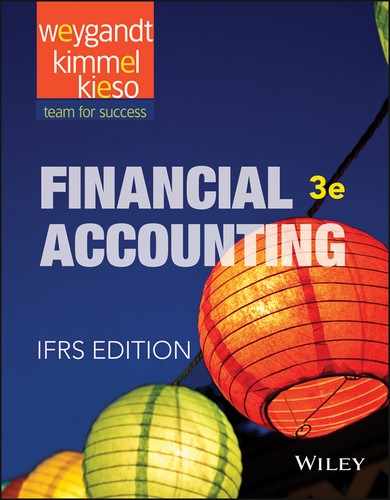CHAPTER 8
Accounting for Receivables
FEATURE STORY
Are You Going to Pay Me—or Not?
What is the only thing harder than making a sale? Answer: Collecting the cash. Just ask a banker, virtually any banker. Bankers around the world have been awash in “doubtful” loans for years. And, it may be many years before the mess is finally cleaned up.
If your business sells most of its goods on credit or is in the business of making loans, then accurately recording your receivables is one of your most important accounting tasks. At the end of every accounting period, companies are required to estimate how many of their receivables are “uncollectible.” A significant decline in the amount of estimated doubtful loans can send a company’s share price soaring. For example, BNP Paribas (FRA) reported a decline in the estimated provision for doubtful loans of more than 50%. The market reacted very favorably, with the company’s share price rising by 5.3% in one day.
On the other hand, when a company announces an unexpected increase in its estimated doubtful loans, the securities market often reacts severely. For example, BBVA (ESP) announced that it was increasing its estimated provision for doubtful loans by €164 million. Its share price fell by 6% in a single day.
No bank is spared scrutiny of its estimated doubtful loans. In fact, it is likely that no number in a bank’s financial statements receives more careful investigation by financial analysts and investors. Nearly three years after the beginning of the financial crisis, Bank of America’s (USA) share price was still in single digits (after hitting a high of $54 per share) primarily because of investor concern regarding its provision for doubtful loans. And, on the other side of the globe, in Iran, one banker suggested that as many as 20% of the loans held by that country’s banks are doubtful.
Sources: Ben Hall, “Fall in Bad Loans Boosts BNP Paribas,” Financial Times Online (FT.com) (August 2, 2010); Tracy Alloway, “BBVA, an Exercise in Spanish Banking Losses,” Financial Times Online (FT.com) (February 3, 2011); and Najmeh Bozorgmehr, “Private Banks Open to Assist Tehran Insiders,” Financial Times Online (FT.com) (May 9, 2011).


PREVIEW OF CHAPTER 8
As indicated in the Feature Story, receivables are a significant asset for banks. Because a large portion of sales are credit sales, receivables are important to companies in other industries as well. As a consequence, companies must pay close attention to their receivables and manage them carefully. In this chapter, you will learn what journal entries companies make when they sell products, when they collect cash from those sales, and when they write off accounts they cannot collect.
The content and organization of the chapter are as follows.
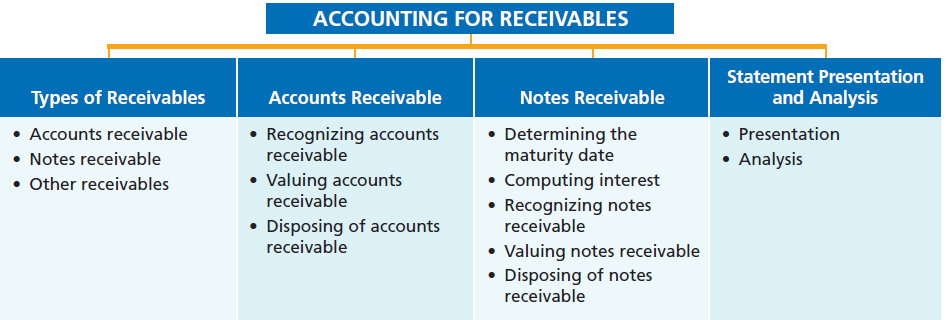
 The Navigator
The Navigator
Types of Receivables
Learning Objective 1
Identify the different types of receivables.
The term receivables refers to amounts due from individuals and companies. Receivables are claims that are expected to be collected in cash. The management of receivables is a very important activity for any company that sells goods or services on credit.
Receivables are important because they represent one of a company’s most liquid assets. For many companies, receivables are also one of the largest assets. Illustration 8-1 lists receivables as a percentage of total assets for five well-known companies in a recent year.
Illustration 8-1 Receivables as a percentage of assets
| Company | Receivables as a Percentage of Total Assets |
| adidas (DEU) | 16% |
| Hyundai (KOR) | 5 |
| Samsung (KOR) | 13 |
| Nestlé (CHE) | 41 |
| China Mobile Limited (HKG) | 2 |
The relative significance of a company’s receivables as a percentage of its assets depends on various factors: its industry, the time of year, whether it extends long-term financing, and its credit policies. To reflect important differences among receivables, they are frequently classified as (1) accounts receivable, (2) notes receivable, and (3) other receivables.
Accounts receivable are amounts customers owe on account. They result from the sale of goods and services. Companies generally expect to collect accounts receivable within 30 to 60 days. They are usually the most significant type of claim held by a company.
Notes receivable are a written promise (as evidenced by a formal instrument) for amounts to be received. The note normally requires the collection of interest and extends for time periods of 60–90 days or longer. Notes and accounts receivable that result from sales transactions are often called trade receivables.
Other receivables include non-trade receivables such as interest receivable, loans to company officers, advances to employees, and income taxes refundable. These do not generally result from the operations of the business. Therefore, they are generally classified and reported as separate items in the statement of financial position.
Accounts Receivable
Learning Objective 2
Explain how companies recognize accounts receivable.
Recognizing Accounts Receivable
Recognizing accounts receivable is relatively straightforward. A service organization records a receivable when it performs a service on account. A merchandiser records accounts receivable at the point of sale of merchandise on account. When a merchandiser sells goods, it increases (debits) Accounts Receivable and increases (credits) Sales Revenue.
The seller may offer terms that encourage early payment by providing a discount. Sales returns also reduce receivables. The buyer might find some of the goods unacceptable and choose to return the unwanted goods.
To review, assume that Hennes & Mauritz (SWE) on July 1, 2017, sells merchandise on account to Polo Company for $1,000, terms 2/10, n/30. On July 5, Polo returns merchandise with a sales price of $100 to Hennes & Mauritz. On July 11, Hennes & Mauritz receives payment from Polo Company for the balance due. The journal entries to record these transactions on the books of Hennes & Mauritz are as follows. (Cost of goods sold entries are omitted.)
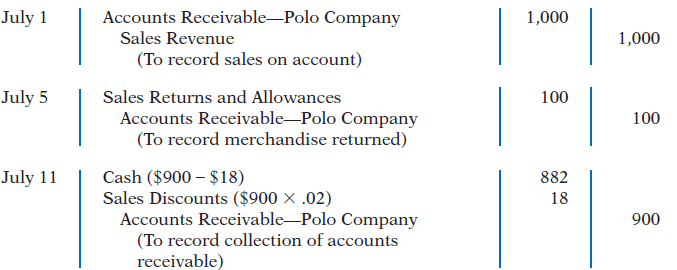
• HELPFUL HINT
These entries are the same as those described in Chapter 5. For simplicity, we have omitted inventory and cost of goods sold from this set of journal entries and from end-of-chapter material.
Some retailers issue their own credit cards. When you use a retailer’s credit card (JCPenney (USA), for example), the retailer charges interest on the balance due if not paid within a specified period (usually 25–30 days).
To illustrate, assume that you use your JCPenney credit card to purchase clothing with a sales price of $300 on June 1, 2017. JCPenney will increase (debit) Accounts Receivable for $300 and increase (credit) Sales Revenue for $300 (cost of goods sold entry omitted) as follows.

Assuming that you owe $300 at the end of the month, and JCPenney charges 1.5% per month on the balance due, the adjusting entry that JCPenney makes to record interest revenue of $4.50 on June 30 is as follows.

Interest revenue is often substantial for many retailers.
> DO IT!
Recognizing Accounts Receivable
On May 1, Wilton sold merchandise on account to Bates for €50,000 terms 3/15, net 45. On May 4, Bates returns merchandise with a sales price of €2,000. On May 16, Wilton receives payment from Bates for the balance due. Prepare journal entries to record the May transactions on Wilton’s books. (You may ignore cost of goods sold entries and explanations.)
Action Plan
- ✓ Prepare entry to record the receivable and related return.
- ✓ Compute the sales discount and related entry.
Solution

Related exercise material:BE8-2, E8-1, E8-2, and DO IT! 8-1.
 The Navigator
The Navigator
Learning Objective 3
Distinguish between the methods and bases companies use to value accounts receivable.
Valuing Accounts Receivable
Once companies record receivables in the accounts, the next question is: How should they report receivables in the financial statements? Companies report accounts receivable on the statement of financial position as an asset. But determining the amount to report is sometimes difficult because some receivables will become uncollectible.
Each customer must satisfy the credit requirements of the seller before the credit sale is approved. Inevitably, though, some accounts receivable become uncollectible. For example, a customer may not be able to pay because of a decline in its sales revenue due to a downturn in the economy. Similarly, individuals may be laid off from their jobs or faced with unexpected hospital bills. Companies record credit losses as debits to Bad Debt Expense (or Uncollectible Accounts Expense). Such losses are a normal and necessary risk of doing business on a credit basis. Recently, when home prices in many parts of the world fell, home foreclosures rose and lenders experienced huge increases in their bad debt expense.
• Alternative Terminology
You will sometimes see Bad Debt Expense called Uncollectible Accounts Expense.
Two methods are used in accounting for uncollectible accounts: (1) the direct write-off method and (2) the allowance method. The following sections explain these methods.
DIRECT WRITE-OFF METHOD FOR UNCOLLECTIBLE ACCOUNTS
Under the direct write-off method, when a company determines a particular account to be uncollectible, it charges the loss to Bad Debt Expense. Assume, for example, that Warden Ltd. writes off as uncollectible M. E. Doran’s HK$1,600 balance on December 12. Warden’s entry is as follows.

Under this method, Bad Debt Expense will show only actual losses from uncollectibles. The company will report accounts receivable at its gross amount.
Although this method is simple, its use can reduce the usefulness of both the income statement and statement of financial position. Consider the following example. Assume that in 2017, Quick Buck Computer Ltd. decided it could increase its revenues by offering computers to college students without requiring any money down and with no credit-approval process. On campuses across the country, it distributed one million computers with a selling price of HK$6,400 each. This increased Quick Buck’s revenues and receivables by HK$6,400 million. The promotion was a huge success! The 2017 statement of financial position and income statement looked great. Unfortunately, during 2018, nearly 40% of the customers defaulted on their loans. This made the 2018 income statement and statement of financial position look terrible. Illustration 8-2 shows the effects of these events on the financial statements if the direct write-off method is used.
Illustration 8-2 Effects of direct write-off method
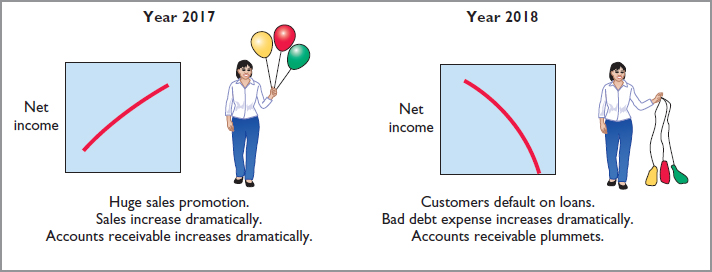
Under the direct write-off method, companies often record bad debt expense in a period different from the period in which they record the revenue. The method does not attempt to match bad debt expense to sales revenue in the income statement. Nor does the direct write-off method show accounts receivable in the statement of financial position at the amount the company actually expects to receive. Consequently, unless bad debt losses are insignificant, the direct write-off method is not acceptable for financial reporting purposes.
ALLOWANCE METHOD FOR UNCOLLECTIBLE ACCOUNTS
The allowance method of accounting for bad debts involves estimating uncollectible accounts at the end of each period. This provides better matching on the income statement. It also ensures that companies state receivables on the statement of financial position at their cash (net) realizable value. Cash (net) realizable value is the net amount the company expects to receive in cash.1
IFRS requires the allowance method for financial reporting purposes when bad debts are material in amount. This method has three essential features:
• HELPFUL HINT
In this context, material means significant or important to financial statement users.
- Companies estimate uncollectible accounts receivable. They match this estimated expense against revenues in the same accounting period in which they record the revenues.
- Companies debit estimated uncollectibles to Bad Debt Expense and credit them to Allowance for Doubtful Accounts through an adjusting entry at the end of each period. Allowance for Doubtful Accounts is a contra account to Accounts Receivable.
- When companies write off a specific account, they debit actual uncollectibles to Allowance for Doubtful Accounts and credit that amount to Accounts Receivable.
RECORDING ESTIMATED UNCOLLECTIBLES To illustrate the allowance method, assume that Hampson Furniture has credit sales of €1,200,000 in 2017. Of this amount, €200,000 remains uncollected at December 31. The credit manager estimates that €12,000 of these sales will be uncollectible. The adjusting entry to record the estimated uncollectibles increases (debits) Bad Debt Expense and increases (credits) Allowance for Doubtful Accounts, as follows.

Hampson reports Bad Debt Expense in the income statement as an operating expense (usually as a selling expense). Thus, the estimated uncollectibles are matched with sales in 2017. Hampson records the expense in the same year it made the sales.
Allowance for Doubtful Accounts shows the estimated amount of claims on customers that the company expects will become uncollectible in the future. Companies use a contra account instead of a direct credit to Accounts Receivable because they do not know which customers will not pay. The credit balance in the allowance account will absorb the specific write-offs when they occur. As Illustration 8-3 shows, the company deducts the allowance account from accounts receivable in the current assets section of the statement of financial position.
Illustration 8-3 Presentation of allowance for doubtful accounts
| HAMPSON FURNITURE Statement of Financial Position (partial) |
||||
| Current assets | ||||
| Supplies | € 25,000 |
|||
| Inventory | 310,000 |
|||
| Accounts receivable | €200,000 |
|||
| Less: Allowance for doubtful accounts | 12,000 |
188,000 |
||
| Cash | 14,800 |
|||
| Total current assets | €537,800 |
|||
The amount of €188,000 in Illustration 8-3 represents the expected cash realizable value of the accounts receivable at the statement date. Companies do not close Allowance for Doubtful Accounts at the end of the fiscal year.
• HELPFUL HINT
Cash realizable value is sometimes referred to as accounts receivable (net).
RECORDING THE WRITE-OFF OF AN UNCOLLECTIBLE ACCOUNT Companies use various methods of collecting past-due accounts, such as letters, calls, and legal action. When they have exhausted all means of collecting a past-due account and collection appears impossible, the company should write off the account. In the credit card industry, for example, it is standard practice to write off accounts that are 210 days past due. To prevent premature or unauthorized write-offs, authorized management personnel should formally approve each write-off. To maintain segregation of duties, the employee authorized to write off accounts should not have daily responsibilities related to cash or receivables.
To illustrate a receivables write-off, assume that the financial vice president of Hampson Furniture authorizes a write-off of the €500 balance owed by R. A. Ware on March 1, 2018. The entry to record the write-off is as follows.

Bad Debt Expense does not increase when the write-off occurs. Under the allowance method, companies debit every bad debt write-off to the allowance account rather than to Bad Debt Expense. A debit to Bad Debt Expense would be incorrect because the company has already recognized the expense when it made the adjusting entry for estimated bad debts. Instead, the entry to record the write-off of an uncollectible account reduces both Accounts Receivable and Allowance for Doubtful Accounts. After posting, the general ledger accounts appear as shown in Illustration 8-4.
Illustration 8-4 General ledger balances after write-off

A write-off affects only statement of financial position accounts—not income statement accounts. The write-off of the account reduces both Accounts Receivable and Allowance for Doubtful Accounts. Cash realizable value in the statement of financial position, therefore, remains the same, as Illustration 8-5 shows.
Illustration 8-5 Cash realizable value comparison
| Before Write-Off | After Write-Off | |
| Accounts receivable | € 200,000 |
€ 199,500 |
| Less: Allowance for doubtful accounts | 12,000 |
11,500 |
| Cash realizable value | €188,000 |
€188,000 |
RECOVERY OF AN UNCOLLECTIBLE ACCOUNT Occasionally, a company collects from a customer after it has written off the account as uncollectible. The company makes two entries to record the recovery of a bad debt. (1) It reverses the entry made in writing off the account. This reinstates the customer’s account. (2) It journalizes the collection in the usual manner.
To illustrate, assume that on July 1, R. A. Ware pays the €500 amount that Hampson had written off on March 1. Hampson makes the following entries.

Note that the recovery of a bad debt, like the write-off of a bad debt, affects only statement of financial position accounts. The net effect of the two entries above is a debit to Cash and a credit to Allowance for Doubtful Accounts for €500. Accounts Receivable and the Allowance for Doubtful Accounts both increase in entry (1) for two reasons. First, the company made an error in judgment when it wrote off the account receivable. Second, after R. A. Ware did pay, Accounts Receivable in the general ledger and Ware’s account in the subsidiary ledger should show the collection for possible future credit purposes.
ESTIMATING THE ALLOWANCE For Hampson Furniture in Illustration 8-3, the amount of the expected uncollectibles was given. However, in “real life,” companies must estimate that amount when they use the allowance method. One of two bases is used to determine this amount: (1) percentage of sales or (2) percentage of receivables. Both bases are generally accepted. The choice is a management decision. It depends on the relative emphasis that management wishes to give to expenses and revenues on the one hand or to cash realizable value of the accounts receivable on the other. The choice is whether to emphasize income statement or statement of financial position relationships. Illustration 8-6 compares the two bases.
Illustration 8-6 Comparison of bases for estimating uncollectibles
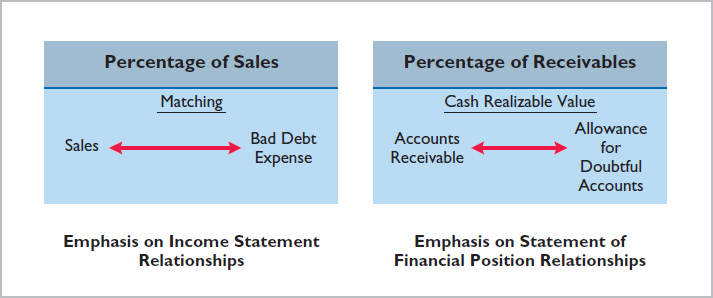
The percentage-of-sales basis results in a better matching of expenses with revenues—an income statement viewpoint. The percentage-of-receivables basis produces the better estimate of cash realizable value—a statement of financial position viewpoint. Under both bases, the company must determine its past experience with bad debt losses.
Percentage-of-Sales. In the percentage-of-sales basis, management estimates what percentage of credit sales will be uncollectible. This percentage is based on past experience and anticipated credit policy.
The company applies this percentage to either total credit sales or net credit sales of the current year. To illustrate, assume that Gonzalez SA elects to use the percentage-of-sales basis. It concludes that 1% of net credit sales will become uncollectible. If net credit sales for 2017 are €800,000, the estimated bad debt expense is €8,000 . The adjusting entry is as follows.

After the adjusting entry is posted, assuming the allowance account already has a credit balance of €1,723, the accounts of Gonzalez SA will show the following.
Illustration 8-7 Bad debt accounts after posting

This basis of estimating uncollectibles emphasizes the matching of expenses with revenues. As a result, Bad Debt Expense will show a direct percentage relationship to the sales base on which it is computed. When the company makes the adjusting entry, it disregards the existing balance in Allowance for Doubtful Accounts. The adjusted balance in this account when netted against accounts receivable should be a reasonable approximation of the realizable value of the receivables. If actual write-offs differ significantly from the amount estimated, the company should modify the percentage for future years.
Percentage-of-Receivables. Under the percentage-of-receivables basis, management estimates what percentage of receivables will result in losses from uncollectible accounts. The company prepares an aging schedule, in which it classifies customer balances by the length of time they have been unpaid. Because of its emphasis on time, the analysis is often called aging the accounts receivable.
• HELPFUL HINT
Where appropriate, the percentage-of-receivables basis may use only a single percentage rate.
After the company arranges the accounts by age, it determines the expected bad debt losses. It applies percentages based on past experience to the totals in each category. The longer a receivable is past due, the less likely it is to be collected. Thus, the estimated percentage of uncollectible debts increases as the number of days past due increases. Illustration 8-8 (page 392) shows an aging schedule for Dart Company Ltd. Note that the estimated percentage uncollectible increases from 2% to 40% as the number of days past due increases.

Total estimated bad debts for Dart (![]() 2,228,000) represent the amount of existing customer claims the company expects will become uncollectible in the future. This amount represents the required balance in Allowance for Doubtful Accounts at the statement of financial position date. The amount of the bad debt adjusting entry is the difference between the required balance and the existing balance in the allowance account. If the trial balance shows Allowance for Doubtful Accounts with a credit balance of
2,228,000) represent the amount of existing customer claims the company expects will become uncollectible in the future. This amount represents the required balance in Allowance for Doubtful Accounts at the statement of financial position date. The amount of the bad debt adjusting entry is the difference between the required balance and the existing balance in the allowance account. If the trial balance shows Allowance for Doubtful Accounts with a credit balance of ![]() 528,000, the company will make an adjusting entry for
528,000, the company will make an adjusting entry for ![]() 1,700,000 (
1,700,000 (![]() 2,228,000 −
2,228,000 − ![]() 528,000), as shown here (
528,000), as shown here (![]() in thousands).
in thousands).
Illustration 8-8 Aging schedule
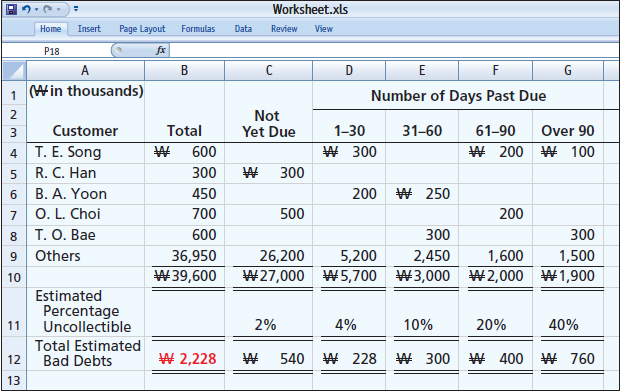
• HELPFUL HINT
The older categories have higher percentages because the longer an account is past due, the less likely it is to be collected.
After Dart posts its adjusting entry, its accounts will appear as follows (![]() in thousands).
in thousands).
Illustration 8-9 Bad debt accounts after posting

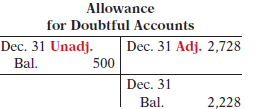
Occasionally, the allowance account will have a debit balance prior to adjustment. This occurs when write-offs during the year have exceeded previous provisions for bad debts. In such a case, the company adds the debit balance to the required balance when it makes the adjusting entry. Thus, if there had been a ![]() 500,000 debit balance in the allowance account before adjustment, the adjusting entry would have been for
500,000 debit balance in the allowance account before adjustment, the adjusting entry would have been for ![]() 2,728,000 (
2,728,000 (![]() 2,228,000 +
2,228,000 + ![]() 500,000) to arrive at a credit balance of
500,000) to arrive at a credit balance of ![]() 2,228,000. The percentage-of-receivables basis will normally result in the better approximation of cash realizable value.
2,228,000. The percentage-of-receivables basis will normally result in the better approximation of cash realizable value.
> DO IT!
Uncollectible Accounts Receivable
Brule Co. has been in business for five years. The unadjusted trial balance at the end of the current year shows:
| Accounts Receivable | $30,000 Dr. |
| Sales Revenue | $180,000 Cr. |
| Allowance for Doubtful Accounts | $2,000 Dr. |
Bad debts are estimated to be 10% of receivables. Prepare the entry to adjust Allowance for Doubtful Accounts.
Action Plan
- ✓ Estimate the amount the company does not expect to collect.
- ✓ Consider the existing balance in the allowance account when using the percentage-of-receivables basis.
- ✓ Report receivables at their cash (net) realizable value.
Solution
The following entry should be made to bring the balance in Allowance for Doubtful Accounts up to a normal credit balance of $3,000 :

Related exercise material: BE8-3, BE8-4, BE8-5, BE8-6, BE8-7, E8-3, E8-4, E8-5, and DO IT! 8-2.
 The Navigator
The Navigator
Disposing of Accounts Receivable
Learning Objective 4
Describe the entries to record the disposition of accounts receivable.
In the normal course of events, companies collect accounts receivable in cash and remove the receivables from the books. However, as credit sales and receivables have grown in significance, the “normal course of events” has changed. Companies now frequently sell their receivables to another company for cash, thereby shortening the cash-to-cash operating cycle.
Companies sell receivables for two major reasons. First, they may be the only reasonable source of cash. When money is tight, companies may not be able to borrow money in the usual credit markets. Or, if money is available, the cost of borrowing may be prohibitive.
A second reason for selling receivables is that billing and collection are often time-consuming and costly. It is often easier for a retailer to sell the receivables to another party with expertise in billing and collection matters. Credit card companies such as MasterCard (USA) and Visa (USA) specialize in billing and collecting accounts receivable. MasterCard and Visa credit cards are issued by banks around the world, including ICBC (CHN), BNP Paribas (FRA), and Barclays (GBR).
SALE OF RECEIVABLES
A common sale of receivables is a sale to a factor. A factor is a finance company or bank that buys receivables from businesses and then collects the payments directly from the customers. Factoring is a multibillion dollar business.
Factoring arrangements vary widely. Typically, the factor charges a commission to the company that is selling the receivables. This fee ranges from 1–3% of the amount of receivables purchased. To illustrate, assume that Tsai Furniture factors NT$600,000 of receivables to Federal Factors. Federal Factors assesses a service charge of 2% of the amount of receivables sold. The journal entry to record the sale by Tsai Furniture on April 2, 2017, is as follows.

If the company often sells its receivables, it records the service charge expense (such as that incurred by Tsai) as a selling expense. If the company infrequently sells receivables, it may report this amount in the “Other income and expense” section of the income statement.
CREDIT CARD SALES
Credit card use is becoming widespread around the world. ICBC is among the largest credit card issuers in the world. Visa and MasterCard are the credit cards that most individuals use. Three parties are involved when credit cards are used in retail sales: (1) the credit card issuer, who is independent of the retailer; (2) the retailer; and (3) the customer. A retailer’s acceptance of a national credit card is another form of selling (factoring) the receivable.
Illustration 8-10 (page 394) shows the major advantages of credit cards to the retailer. In exchange for these advantages, the retailer pays the credit card issuer a fee of 2–6% of the invoice price for its services.
ACCOUNTING FOR CREDIT CARD SALES The retailer generally considers sales from the use of credit card sales as cash sales. The retailer must pay to the bank that issues the card a fee for processing the transactions. The retailer records the credit card slips in a similar manner as checks deposited from a cash sale.
Illustration 8-10 Advantages of credit cards to the retailer

To illustrate, Lee Co. Ltd. purchases NT$6,000 of music downloads for its restaurant from Yang Music, using a Visa First Bank Card. First Bank charges a service fee of 3%. The entry to record this transaction by Yang Music on March 22, 2018, is as follows.

Accounting Across the Organization
How Does a Credit Card Work?
PPR (FRA)

Most of you know how to use a credit card, but do you know what happens in the transaction and how the transaction is processed? Suppose that you use a Visa card to purchase some new ties at PPR (FRA). The salesperson swipes your card, which allows the information on the magnetic strip on the back of the card to be read. The salesperson then enters the amount of the purchase. The machine contacts the Visa computer, which routes the call back to the bank that issued your Visa card. The issuing bank verifies that the account exists, that the card is not stolen, and that you have not exceeded your credit limit. At this point, the slip is printed, which you sign.
Visa acts as the clearing agent for the transaction. It transfers funds from the issuing bank to PPR’s bank account. Generally this transfer of funds, from sale to the receipt of funds in the merchant’s account, takes two to three days.
In the meantime, Visa puts a pending charge on your account for the amount of the tie purchase; that amount counts immediately against your available credit limit. At the end of the billing period, Visa sends you an invoice (your credit card bill) which shows the various charges you made, and the amounts that Visa expended on your behalf, for the month. You then must “pay the piper” for your stylish new ties.
Q Assume that PPR prepares a bank reconciliation at the end of each month. If some credit card sales have not been processed by the bank, how should PPR treat these transactions on its bank reconciliation? (See page 422.)
> DO IT!
Disposition of Accounts Receivable
Mehl Wholesalers NV has been expanding faster than it can raise capital. According to its local banker, the company has reached its debt ceiling. Mehl’s suppliers (creditors) are demanding payment within 30 days of the invoice date for goods acquired, but Mehl’s customers are slow in paying (60–90 days). As a result, Mehl has a cash flow problem.
Mehl needs €120,000 in cash to safely cover next Friday’s payroll. Its balance of outstanding accounts receivables totals €750,000. To alleviate this cash crunch, the company sells €125,000 of its receivables on September 7, 2017. Mehl is charged a 1% service charge on this sale. Record the entry that Mehl would make when it raises the needed cash.
Action Plan
- ✓ To speed up the collection of cash, sell receivables to a factor.
- ✓ Calculate service charge expense as a percentage of the factored receivables.
Solution
If Mehl Wholesalers factors €125,000 of its accounts receivable at a 1% service charge, it would make the following entry.

Related exercise material: BE8-8, E8-7, E8-8, E8-9, and DO IT! 8-3.
 The Navigator
The Navigator
Notes Receivable
Learning Objective 5
Compute the maturity date of and interest on notes receivable.
Companies may also grant credit in exchange for a formal credit instrument known as a promissory note. A promissory note is a written promise to pay a specified amount of money on demand or at a definite time. Promissory notes may be used (1) when individuals and companies lend or borrow money, (2) when the amount of the transaction and the credit period exceed normal limits, or (3) in settlement of accounts receivable.
In a promissory note, the party making the promise to pay is called the maker. The party to whom payment is to be made is called the payee. The note may specifically identify the payee by name or may designate the payee simply as the bearer of the note.
In the note shown in Illustration 8-11, Calhoun plc is the maker, and Wilma Ltd. is the payee. To Wilma Ltd., the promissory note is a note receivable. To Calhoun plc, it is a note payable.
Illustration 8-11 Promissory note
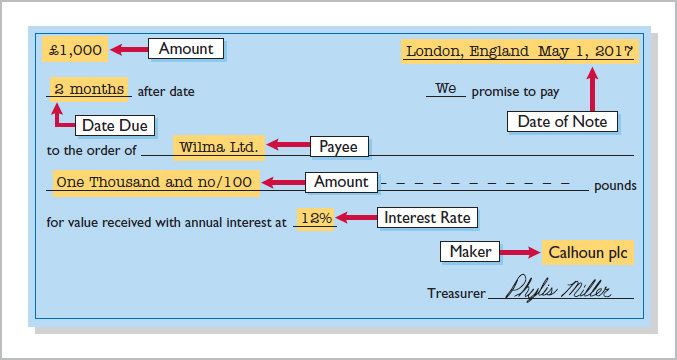
• HELPFUL HINT
For this note, the maker, Calhoun plc, debits Cash and credits Notes Payable. The payee, Wilma Ltd., debits Notes Receivable and credits Cash.
Notes receivable give the holder a stronger legal claim to assets than do accounts receivable. Like accounts receivable, notes receivable can be readily sold to another party. Promissory notes are negotiable instruments (as are checks), which means that they can be transferred to another party by endorsement.
Companies frequently accept notes receivable from customers who need to extend the payment of an outstanding account receivable. They often require such notes from high-risk customers. In some industries (such as the pleasure and sport boat industry), all credit sales are supported by notes. The majority of notes, however, originate from loans.
The basic issues in accounting for notes receivable are the same as those for accounts receivable:
- Recognizing notes receivable.
- Valuing notes receivable.
- Disposing of notes receivable.
On the following pages, we look at these issues. Before we do, however, we need to consider two issues that do not apply to accounts receivable: determining the maturity date and computing interest.
Determining the Maturity Date
When the life of a note is expressed in terms of months, you find the date when it matures by counting the months from the date of issue. For example, the maturity date of a three-month note dated May 1 is August 1. A note drawn on the last day of a month matures on the last day of a subsequent month. That is, a July 31 note due in two months matures on September 30.
When the due date is stated in terms of days, you need to count the exact number of days to determine the maturity date. In counting, omit the date the note is issued but include the due date. For example, the maturity date of a 60-day note dated July 17 is September 15, computed as follows.
Illustration 8-12 Computation of maturity date
| Term of note | 60 days | |
| July (31–17) | 14 | |
| August | 31 | 45 |
| Maturity date: September | 15 |
Illustration 8-13 shows three ways of stating the maturity date of a promissory note.
Illustration 8-13 Maturity date of different notes
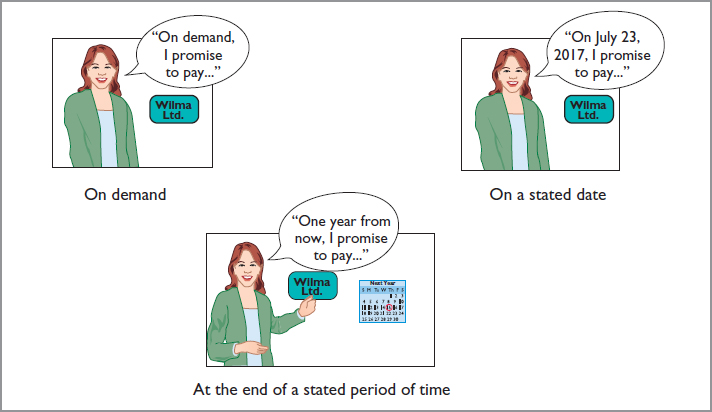
Computing Interest
Illustration 8-14 gives the basic formula for computing interest on an interest-bearing note.
Illustration 8-14 Formula for computing interest

The interest rate specified in a note is an annual rate of interest. The time factor in the formula in Illustration 8-14 expresses the fraction of a year that the note is outstanding. When the maturity date is stated in days, the time factor is often the number of days divided by 360. When counting days, omit the date that the note is issued but include the due date. When the due date is stated in months, the time factor is the number of months divided by 12. Illustration 8-15 shows computation of interest for various time periods.
• HELPFUL HINT
The interest rate specified is the annual rate.
Illustration 8-15 Computation of interest

There are different ways to calculate interest. For example, the computation in Illustration 8-15 assumes 360 days for the length of the year. Most financial instruments use 365 days to compute interest. For homework problems, assume 360 days to simplify computations.
Recognizing Notes Receivable
Learning Objective 6
Explain how companies recognize notes receivable.
To illustrate the basic entry for notes receivable, we will use Calhoun plc’s £1,000, two-month, 12% promissory note dated May 1. Assuming that Calhoun plc wrote the note to settle an open account, Wilma Ltd. makes the following entry for the receipt of the note.

The company records the note receivable at its face value, the amount shown on the face of the note. No interest revenue is reported when the note is accepted because the revenue recognition principle does not recognize revenue until the performance obligation is satisfied. Interest is earned (accrued) as time passes.
If a company lends money using a note, the entry is a debit to Notes Receivable and a credit to Cash in the amount of the loan.
Valuing Notes Receivable
Learning Objective 7
Describe how companies value notes receivable.
Valuing short-term notes receivable is the same as valuing accounts receivable. Like accounts receivable, companies report short-term notes receivable at their cash (net) realizable value. The notes receivable allowance account is Allowance for Doubtful Accounts. The estimations involved in determining cash realizable value and in recording bad debt expense and the related allowance are done similarly to accounts receivable.
Global Insight
Can Fair Value Be Unfair?

The IASB and the Financial Accounting Standards Board (FASB) are considering proposals for how to account for financial instruments. The FASB has proposed that loans and receivables be accounted for at their fair value (the amount they could currently be sold for), as are most investments. The FASB believes that this would provide a more accurate view of a company’s financial position. It might be especially useful as an early warning when a bank is in trouble because of poor-quality loans. But, banks argue that fair values are difficult to estimate accurately. They are also concerned that volatile fair values could cause large swings in a bank’s reported net income. As a result, the IASB issued a standard that instead accounts for loans at amortized cost.
Source: David Reilly, “Banks Face a Mark-to-Market Challenge,” Wall Street Journal Online (March 15, 2010).
Q What are the arguments in favor of and against fair value accounting for loans and receivables? (See page 422.)
Disposing of Notes Receivable
Learning Objective 8
Describe the entries to record the disposition of accounts receivable.
Notes may be held to their maturity date, at which time the face value plus accrued interest is due. In some situations, the maker of the note defaults, and the payee must make an appropriate adjustment. In other situations, similar to accounts receivable, the holder of the note speeds up the conversion to cash by selling the receivables. The accounting entries for the sale of notes receivable are left for a more advanced class.
HONOR OF NOTES RECEIVABLE
A note is honored when its maker pays in full at its maturity date. For each interest-bearing note, the amount due at maturity is the face value of the note plus interest for the length of time specified on the note.
To illustrate, assume that Wolder Co. lends Higley Co. €10,000 on June 1, accepting a five-month, 9% interest note. In this situation, interest is €375 . The amount due, the maturity value, is €10,375 . To obtain payment, Wolder (the payee) must present the note either to Higley Co. (the maker) or to the maker’s agent, such as a bank. If Wolder presents the note to Higley Co. on November 1, the maturity date, Wolder’s entry to record the collection is as follows.

ACCRUAL OF INTEREST RECEIVABLE
Suppose instead that Wolder Co. prepares financial statements as of September 30. The timeline in Illustration 8-16 presents this situation.
Illustration 8-16 Timeline of interest earned

To reflect interest earned but not yet received, Wolder must accrue interest on September 30. In this case, the adjusting entry by Wolder is for four months of interest, or €300, as shown below.

At the note’s maturity on November 1, Wolder receives €10,375. This amount represents repayment of the €10,000 note as well as five months of interest, or $375, as shown below. The €375 is comprised of the €300 Interest Receivable accrued on September 30 plus €75 earned during October. Wolder’s entry to record the honoring of the Higley note on November 1 is as follows.

In this case, Wolder credits Interest Receivable because the receivable was established in the adjusting entry on September 30.
DISHONOR OF NOTES RECEIVABLE
A dishonored (defaulted) note is a note that is not paid in full at maturity. A dishonored note receivable is no longer negotiable. However, the payee still has a claim against the maker of the note for both the note and the interest. Therefore, the note holder usually transfers the Notes Receivable account to an Accounts Receivable account.
To illustrate, assume that Higley Co. on November 1 indicates that it cannot pay at the present time. The entry to record the dishonor of the note depends on whether Wolder Co. expects eventual collection. If it does expect eventual collection, Wolder Co. debits the amount due (face value and interest) on the note to Accounts Receivable. It would make the following entry at the time the note is dishonored (assuming no previous accrual of interest).

If instead on November 1 there is no hope of collection, the note holder would write off the face value of the note by debiting Allowance for Doubtful Accounts. No interest revenue would be recorded because collection will not occur.
Accounting Across the Organization
Filling a Lending Void
Trafalgar Capital Advisors (GBR)

After the global financial crisis, many banks were slow to extend business loans. Companies that needed financing were forced to look to alternative sources. For example, those with significant receivables were sometimes able to use those as a mechanism to get funding. One company, Trafalgar Capital Advisors (GBR), has an investment fund that extends financing supported by receivables, especially on long-term contracts. Examples have included, “suppliers with a large order from a large supermarket chain such as Walmart or Carrefour, which may account for 30 percent of their annual revenue, companies supplying systems to Thomson Reuters on ‘non-cancellable’ contracts, contractors selling to the UK’s Ministry of Defence (‘they never get paid on time’), and an organiser of international golf tournaments with long-term contracts but lumpy revenue streams.” The company does not like to lend on “intangible” collateral, such as that of biotech or software companies.
Source: Steve Johnson, “Few Fund Managers Filling Bank Lending Void,” Financial Times Online (FT.com) (January 9, 2011).
Q Why do you suppose the company prefers to extend credit supported by receivables rather than intangible assets? (See page 422.)
> DO IT!
Merchandising Operations and Inventory Systems
Gambit Stores accepts from Leonard SpA a €3,400, 90-day, 6% note dated May 10 in settlement of Leonard’s overdue account. (a) What is the maturity date of the note? (b) What entry does Gambit make at the maturity date, assuming Leonard pays the note and interest in full at that time?
Action Plan
- ✓ Count the exact number of days to determine the maturity date. Omit the date the note is issued, but include the due date.
- ✓ Determine whether interest was accrued.
- ✓ Compute the accrued interest.
- ✓ Prepare the entry for collection of the note and interest.
- ✓ The entry to record interest at maturity in this solution assumes no interest has been previously accrued on this note.
Solution
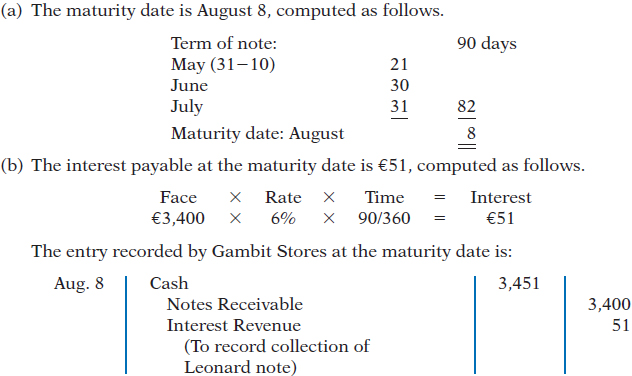
Related exercise material: BE8-9, BE8-10, E8-10, E8-11, E8-12, E8-13, and DO IT! 8-4.
 The Navigator
The Navigator
Statement Presentation and Analysis
Learning Objective 9
Explain the statement presentation and analysis of receivables.
Presentation
Companies should identify in the statement of financial position or in the notes to the financial statements each of the major types of receivables. Short-term receivables appear in the current assets section of the statement of financial position. Short-term investments appear after short-term receivables because these investments are more liquid (nearer to cash). Companies report both the gross amount of receivables and the allowance for doubtful accounts.
In an income statement, companies report bad debt expense and service charge expense as selling expenses in the operating expenses section. Interest revenue appears under “Other income and expense” in the non-operating activities section of the income statement.
Analysis
Investors and corporate managers compute financial ratios to evaluate the liquidity of a company’s accounts receivable. They use the accounts receivable turnover to assess the liquidity of the receivables. This ratio measures the number of times, on average, the company collects accounts receivable during the period. It is computed by dividing net credit sales (net sales less cash sales) by the average net accounts receivable during the year. Unless seasonal factors are significant, average net accounts receivable outstanding can be computed from the beginning and ending balances of net accounts receivable.
For example, in a recent year Lenovo Group (CHN) (which reported in U.S. dollars) had net sales of $38,707 million for the year. It had a beginning accounts receivable (net) balance of $2,885 million and an ending accounts receivable (net) balance of $3,171 million. Assuming that Lenovo’s sales were all on credit, its accounts receivable turnover is computed as follows.
Illustration 8-17 Accounts receivable turnover and computation

The result indicates an accounts receivable turnover of 12.8 times per year. The higher the turnover, the more liquid the company’s receivables.
A variant of the accounts receivable turnover that makes the liquidity even more evident is its conversion into an average collection period in terms of days. This is done by dividing the turnover into 365 days. For example, Lenovo’s turnover of 12.8 times is divided into 365 days, as shown in Illustration 8-18, to obtain approximately 28.5 days. This means that it takes Lenovo on average 28.5 days to collect its accounts receivable.
Illustration 8-18 Average collection period for receivables formula and computation

Companies frequently use the average collection period to assess the effectiveness of a company’s credit and collection policies. The general rule is that the collection period should not greatly exceed the credit term period (that is, the time allowed for payment).
> DO IT!
Analysis of Receivables
In 2017, Rafael Nadal SA has net credit sales of €923,795 for the year. It had a beginning accounts receivable (net) balance of €38,275 and an ending accounts receivable (net) balance of €35,988. Compute Rafael Nadal SA’s (a) accounts receivable turnover and (b) average collection period in days.
Action Plan
- ✓ Review the formula to compute the accounts receivable turnover.
- ✓ Make sure that both the beginning and ending accounts receivable balances are considered in the computation.
- ✓ Review the formula to compute the average collection period in days.
Solution

Related exercise material: BE8-12, E8-14, and DO IT! 8-5.
 The Navigator
The Navigator
REVIEW AND PRACTICE
LEARNING OBJECTIVES REVIEW
 The Navigator
The Navigator
- Identify the different types of receivables. Receivables are frequently classified as (1) accounts, (2) notes, and (3) other. Accounts receivable are amounts customers owe on account. Notes receivable are claims for which lenders issue formal instruments of credit as proof of the debt. Other receivables include non-trade receivables such as interest receivable, loans to company officers, advances to employees, and income taxes refundable.
- Explain how companies recognize accounts receivable. Companies record accounts receivable when they perform a service on account or at the point of sale of merchandise on account. Accounts receivable are reduced by sales returns and allowances. Cash discounts reduce the amount received on accounts receivable. When interest is charged on a past due receivable, the company adds this interest to the accounts receivable balance and recognizes it as interest revenue.
- Distinguish between the methods and bases companies use to value accounts receivable. There are two methods of accounting for uncollectible accounts: the allowance method and the direct write-off method. Companies may use either the percentage-of-sales or the percentage-of-receivables basis to estimate uncollectible accounts using the allowance method. The percentage-of-sales basis emphasizes the expense recognition (matching) principle. The percentage-of-receivables basis emphasizes the cash realizable value of the accounts receivable. An aging schedule is often used with this basis.
- Describe the entries to record the disposition of accounts receivable. When a company collects an account receivable, it credits Accounts Receivable. When a company sells (factors) an account receivable, a service charge expense reduces the amount received.
- Compute the maturity date of and interest on notes receivable. For a note stated in months, the maturity date is found by counting the months from the date of issue. For a note stated in days, the number of days is counted, omitting the issue date and counting the due date. The formula for computing interest is .
- Explain how companies recognize notes receivable. Companies record notes receivable at face value. In some cases, it is necessary to accrue interest prior to maturity. In this case, companies debit Interest Receivable and credit Interest Revenue.
- Describe how companies value notes receivable. As with accounts receivable, companies report notes receivable at their cash (net) realizable value. The notes receivable allowance account is Allowance for Doubtful Accounts. The computation and estimations involved in valuing notes receivable at cash realizable value, and in recording the proper amount of bad debt expense and related allowance, are similar to those for accounts receivable.
- Describe the entries to record the disposition of notes receivable. Notes can be held to maturity. At that time the face value plus accrued interest is due, and the note is removed from the accounts. In many cases, the holder of the note speeds up the conversion by selling the receivable to another party (a factor). In some situations, the maker of the note dishonors the note (defaults), in which case the company transfers the note and accrued interest to an account receivable or writes off the note.
- Explain the statement presentation and analysis of receivables. Companies should identify in the statement of financial position or in the notes to the financial statements each major type of receivable. Short-term receivables are considered current assets. Companies report the gross amount of receivables and the allowance for doubtful accounts. They report bad debt and service charge expenses in the income statement as operating (selling) expenses. Interest revenue appears under “Other income and expense” in the non-operating activities section of the statement. Managers and investors evaluate accounts receivable for liquidity by computing a turnover ratio and an average collection period.
GLOSSARY REVIEW
- Accounts receivable
- Amounts owed by customers on account. (p. 384).
- Accounts receivable turnover
- A measure of the liquidity of accounts receivable; computed by dividing net credit sales by average net accounts receivable. (p. 401).
- Aging the accounts receivable
- The analysis of customer balances by the length of time they have been unpaid. (p. 391).
- Allowance method
- A method of accounting for bad debts that involves estimating uncollectible accounts at the end of each period. (p. 387).
- Average collection period
- The average amount of time that a receivable is outstanding; calculated by dividing 365 days by the accounts receivable turnover. (p. 401).
- Bad Debt Expense
- An expense account to record uncollectible receivables. (p. 386).
- Cash (net) realizable value
- The net amount a company expects to receive in cash. (p. 388).
- Direct write-off method
- A method of accounting for bad debts that involves expensing accounts at the time they are determined to be uncollectible. (p. 387).
- Dishonored (defaulted) note
- A note that is not paid in full at maturity. (p. 399).
- Factor
- A finance company or bank that buys receivables from businesses and then collects the payments directly from the customers. (p. 393).
- Maker
- The party in a promissory note who is making the promise to pay. (p. 395).
- Notes receivable
- Written promise (as evidenced by a formal instrument) for amounts to be received. (p. 384).
- Other receivables
- Various forms of non-trade receivables, such as interest receivable and income taxes refundable. (p. 384).
- Payee
- The party to whom payment of a promissory note is to be made. (p. 395).
- Percentage-of-receivables basis
- Management estimates what percentage of receivables will result in losses from uncollectible accounts. (p. 391).
- Percentage-of-sales basis
- Management estimates what percentage of credit sales will be uncollectible. (p. 390).
- Promissory note
- A written promise to pay a specified amount of money on demand or at a definite time. (p. 395).
- Receivables
- Amounts due from individuals and other companies. (p. 384).
- Trade receivables
- Notes and accounts receivable that result from sales transactions. (p. 384).
PRACTICE MULTIPLE-CHOICE QUESTIONS
Receivables are frequently classified as:
- accounts receivable, company receivables, and other receivables.
- accounts receivable, notes receivable, and employee receivables.
- accounts receivable and general receivables.
- accounts receivable, notes receivable, and other receivables.
Buehler Company Ltd. on June 15 sells merchandise on account to Chaz Co. for HK$10,000, terms 2/10, n/30. On June 20, Chaz returns merchandise worth HK$3,000 to Buehler. On June 24, payment is received from Chaz for the balance due. What is the amount of cash received?
- HK$7,000.
- HK$6,800.
- HK$6,860.
- None of the above.
Which of the following approaches for bad debts is best described as a statement of financial position method?
- Percentage-of-receivables basis.
- Direct write-off method.
- Percentage-of-sales basis.
- Both percentage-of-receivables basis and direct write-off method.
Hughes plc has a credit balance of £5,000 in its Allowance for Doubtful Accounts before any adjustments are made at the end of the year. Based on review and aging of its accounts receivable at the end of the year, Hughes estimates that £60,000 of its receivables are uncollectible. The amount of bad debt expense which should be reported for the year is:
- £5,000.
- £55,000.
- £60,000.
- £65,000.
Use the same information as in Question 8-12, except that Hughes has a debit balance of £5,000 in its Allowance for Doubtful Accounts before any adjustments are made at the end of the year. In this situation, the amount of bad debt expense that should be reported for the year is:
- £5,000.
- £55,000.
- £60,000.
- £65,000.
Net sales for the month are
 800,000,000 and bad debts are expected to be 1.5% of net sales. The company uses the percentage-of-sales basis. If Allowance for Doubtful Accounts has a credit balance of
800,000,000 and bad debts are expected to be 1.5% of net sales. The company uses the percentage-of-sales basis. If Allowance for Doubtful Accounts has a credit balance of  15,000,000 before adjustment, what is the balance after adjustment?
15,000,000 before adjustment, what is the balance after adjustment? 15,000,000.
15,000,000. 27,000,000.
27,000,000. 23,000,000.
23,000,000. 31,000,000.
31,000,000.
In 2017, Roso Carlson Ltd. had net credit sales of NT$7,500,000. On January 1, 2017, Allowance for Doubtful Accounts had a credit balance of NT$180,000. During 2017, NT$300,000 of uncollectible accounts receivable were written off. Past experience indicates that 3% of net credit sales become uncollectible. What should be the adjusted balance of Allowance for Doubtful Accounts at December 31, 2017?
- NT$100,500.
- NT$105,000.
- NT$225,000.
- NT$405,000.
An analysis and aging of the accounts receivable of Prince Ltd. at December 31 reveals the following data.
Accounts receivable £800,000Allowance for doubtful accounts per books before adjustment 50,000Amounts expected to become uncollectible 65,000The cash realizable value of the accounts receivable at December 31, after adjustment, is:
- £685,000.
- £750,000.
- £800,000.
- £735,000.
Which of the following statements about Visa credit card sales is incorrect?
- The credit card issuer makes the credit investigation of the customer.
- The retailer is not involved in the collection process.
- Two parties are involved.
- The retailer receives cash more quickly than it would from individual customers on account.
Blinka Retailers accepted €50,000 of Citibank Visa credit card charges for merchandise sold on July 1. Citibank charges 4% for its credit card use. The entry to record this transaction by Blinka Retailers will include a credit to Sales Revenue of €50,000 and a debit(s) to:

One of the following statements about promissory notes is incorrect. The incorrect statement is:
- The party making the promise to pay is called the maker.
- The party to whom payment is to be made is called the payee.
- A promissory note is not a negotiable instrument.
- A promissory note is often required from high-risk customers.
Foti Co. accepts a $1,000, 3-month, 6% promissory note in settlement of an account with Bartelt Co. The entry to record this transaction is as follows.
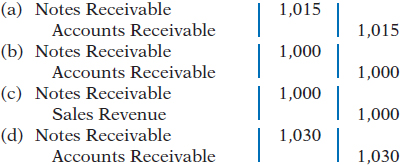
Ginter Co. Ltd. holds Kolar plc’s €10,000, 120-day, 9% note. The entry made by Ginter when the note is collected, assuming no interest has been previously accrued, is:
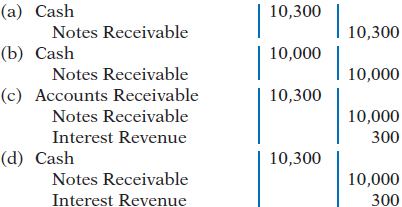
Accounts and notes receivable are reported in the current assets section of the statement of financial position at:
- cash (net) realizable value.
- net book value.
- lower-of-cost-or-net realizable value.
- invoice cost.
Oliveras Company Ltd. had net credit sales during the year of HK$8,000,000 and cost of goods sold of HK$5,000,000. The balance in accounts receivable at the beginning of the year was HK$1,000,000, and the end of the year it was HK$1,500,000. What were the accounts receivable turnover and the average collection period in days?
- 4.0 and 91.3 days.
- 5.3 and 68.9 days.
- 6.4 and 57 days.
- 8.0 and 45.6 days.
Solutions
- (d) Receivables are frequently classified as accounts receivable, notes receivable, and other receivables. The other choices are incorrect because receivables are not frequently classified as (a) company receivables, (b) employee receivables, or (c) general receivables.
- (c) Because payment is received within 10 days of the purchase, the cash received is HK$6,860 . The other choices are incorrect because (a) HK$7,000 does not consider the 2% discount; (b) the amount of the discount is based upon the amount after the return is granted , not the amount before the return of merchandise ; and (d) there is a correct answer.
- (a) The percentage-of-receivables basis is a statement of financial position method because it emphasizes the cash (net) realizable value of accounts receivable. The other choices are incorrect because (b) the direct write-off method is neither a statement of financial position nor an income statement method for accounting for bad debts, (c) the percentage-of-sales basis is an income statement method because it results in a better matching of expenses with revenues, and (d) only the percentage-of-receivables basis is a statement of financial position method, not the direct write-off method.
- (b) By crediting Allowance for Doubtful Accounts for £55,000, the new balance will be the required balance of £60,000. This adjusting entry debits Bad Debt Expense for £55,000 and credits Allowance for Doubtful Accounts for £55,000, not (a) £5,000, (c) £60,000, or (d) £65,000.
- (d) By crediting Allowance for Doubtful Accounts for £65,000, the new balance will be the required balance of £60,000. This adjusting entry debits Bad Debt Expense for £65,000 and credits Allowance for Doubtful Accounts for £65,000, not (a) £5,000, (b) £55,000, or (c) £60,000.
- (b) Net sales times the percentage expected to default equals the amount of bad debt expense for the year (
 800,000,000 × 1.5% =
800,000,000 × 1.5% =  12,000,000). Because this adjusting entry credits Allowance for Doubtful Accounts, the balance after adjustment is
12,000,000). Because this adjusting entry credits Allowance for Doubtful Accounts, the balance after adjustment is  27,000,000 (
27,000,000 ( 15,000,000 +
15,000,000 +  12,000,000), not (a)
12,000,000), not (a)  15,000,000 (c)
15,000,000 (c)  23,000,000 or (d)
23,000,000 or (d)  31,000,000.
31,000,000. - (b) The accounts written off during the year will result in a NT$300,000 debit to Allowance for Doubtful Accounts. The adjusting entry for bad debts will include a NT$225,000 credit to Allowance for Doubtful Accounts. Combining the beginning balance of NT$18,000 credit, the NT$30,000 debit, and the NT$225,000 credit leaves a credit balance of NT$105,000 in the allowance account, not (a) NT$100,500, (c) NT$225,000, or (d) NT$405,000.
- (d) Accounts Receivable less the expected uncollectible amount equals the cash realizable value of £735,000 , not (a) £685,000, (b) £750,000, or (c) £800,000.
- (c) There are three parties, not two, involved in Visa credit card sales: the credit card company, the retailer, and the customer. The other choices are true statements.
- (a) Credit card sales are considered cash sales. Cash is debited €48,000 for the net amount received ( for credit card use fee), and Service Charge Expense is debited €2,000 for the 4% credit card use fee . The other choices are therefore incorrect.
- (c) A promissory note is a negotiable instrument. The other choices are true statements.
- (b) Notes Receivable is recorded at face value ($1,000). No interest on the note is recorded until it is earned. Accounts Receivable is credited because no new sales have been made. The other choices are therefore incorrect.
- (d) Cash is debited for its maturity value , Notes Receivable credited for its face value, and Interest Revenue credited for the amount of interest earned. The other choices are therefore incorrect.
- (a) Accounts Receivable is reported in the current assets section of the statement of financial position at the gross amount less the allowance for doubtful accounts, not at (b) net book value, (c) lower-of-cost-or-net realizable value, or (d) invoice cost.
- (c) The accounts receivable turnover is 6.4 (amounts in thousands). The average collection period in days is 57 days (365/6.4). The other choices are therefore incorrect.
PRACTICE EXERCISES
Journalize entries to record allowance for doubtful accounts using two different bases.
- The ledger of J.C. Cobb Company at the end of the current year shows Accounts Receivable $150,000, Sales Revenue $850,000, and Sales Returns and Allowances $30,000.
Instructions
- If J.C. Cobb uses the direct write-off method to account for uncollectible accounts, journalize the adjusting entry at December 31, assuming J.C. Cobb determines that M. Jack’s $1,500 balance is uncollectible.
- If Allowance for Doubtful Accounts has a credit balance of $2,400 in the trial balance, journalize the adjusting entry at December 31, assuming bad debts are expected to be (1) 1.5% of net sales, and (2) 10% of accounts receivable.
- If Allowance for Doubtful Accounts has a debit balance of $200 in the trial balance, journalize the adjusting entry at December 31, assuming bad debts are expected to be (1) 0.75% of net sales and (2) 6% of accounts receivable.
Solution
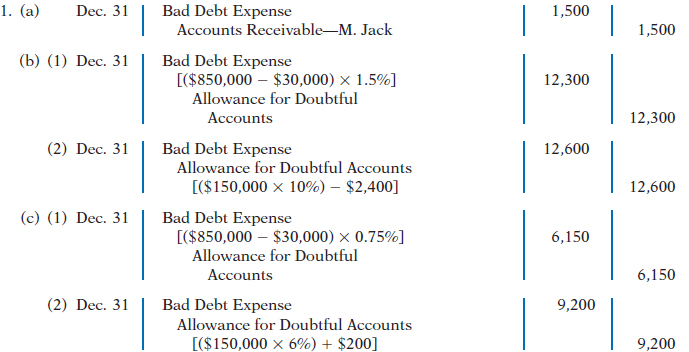
Journalize entries for notes receivable transactions.
- Troope Supply SA has the following transactions related to notes receivable during the last 3 months of 2017.
| Oct. | 1 |
Loaned €16,000 cash to Juan Vasquez on a 1-year, 10% note. |
| Dec. | 11 |
Sold goods to A. Palmer, A/S, receiving a €6,750, 90-day, 8% note. |
16 |
Received a €6,400, 30-day, 9% note in exchange for J. Nicholas’s outstanding accounts receivable. | |
31 |
Accrued interest revenue on all notes receivable. |
Instructions
- Journalize the transactions for Troup Supply.
- Record the collection of the Vasquez note at its maturity in 2018.
Solution
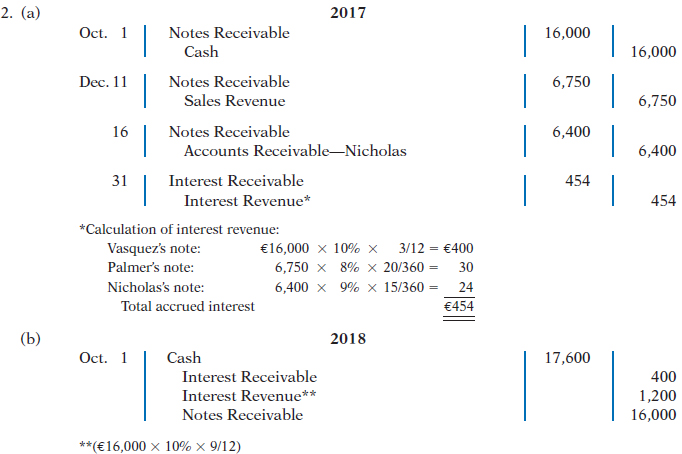
PRACTICE PROBLEM
Prepare entries for various receivables transactions.
The following selected transactions relate to Dylan plc.
| Mar. | 1 |
Sold £20,000 of merchandise to Potter plc, terms 2/10, n/30. |
11 |
Received payment in full from Potter plc for balance due. | |
12 |
Accepted Juno Ltd.’s £20,000, 6-month, 12% note for balance due on existing accounts receivable. | |
13 |
Made Dylan plc credit card sales for £13,200. | |
15 |
Made Visa credit card sales totaling £6,700. A 3% service fee is charged by Visa. | |
| Apr. | 11 |
Sold accounts receivable of £8,000 to Harcot Factor. Harcot Factor assesses a service charge of 2% of the amount of receivables sold. |
13 |
Received collections of £8,200 on Dylan plc credit card sales and added finance charges of 1.5% to the remaining balances. | |
| May | 10 |
Wrote off as uncollectible £16,000 of accounts receivable. Dylan uses the percentage-of-sales basis to estimate bad debts. |
| June | 30 |
Credit sales recorded during the first 6 months total £2,000,000. The bad debt percentage is 1% of credit sales. At June 30, the balance in the allowance account is £3,500 before adjustment. The company prepares financial statements on a semiannual basis. |
| July | 16 |
One of the accounts receivable written off in May was from J. Simon, who pays the amount due, £4,000, in full. |
Instructions
Prepare the journal entries for the transactions.
Solution
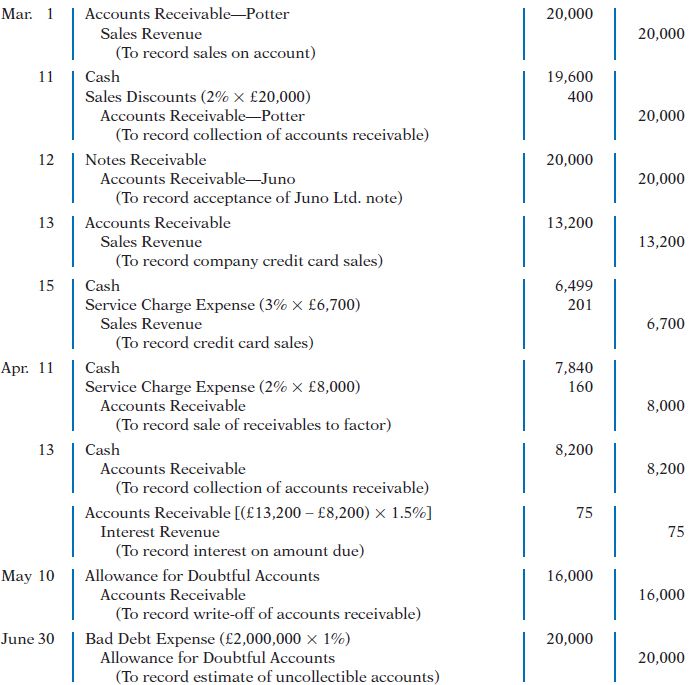

WileyPLUS
Brief Exercises, DO IT! Review, Exercises, and Problems, and many additional resources are available for practice in WileyPLUS.
QUESTIONS
What is the difference between an account receivable and a note receivable?
What are some common types of receivables other than accounts receivable and notes receivable?
Texaco Oil Company (USA) issues its own credit cards. Assume that Texaco charges you $40 interest on an unpaid balance. Prepare the journal entry that Texaco makes to record this revenue.
What are the essential features of the allowance method of accounting for bad debts?
Roger Holloway cannot understand why cash realizable value does not decrease when an uncollectible account is written off under the allowance method. Clarify this point for Roger Holloway.
Distinguish between the two bases that may be used in estimating uncollectible accounts.
Borke Ltd. has a credit balance of NT$320,000 in Allowance for Doubtful Accounts. The estimated bad debt expense under the percentage-of-sales basis is NT$370,000. The total estimated uncollectibles under the percentage-of-receivables basis is NT$580,000. Prepare the adjusting entry under each basis.
How are bad debts accounted for under the direct write-off method? What are the disadvantages of this method?
Freida ASA accepts both its own credit cards and national credit cards. What are the advantages of accepting both types of cards?
An article recently appeared in the Wall Street Journal indicating that companies are selling their receivables at a record rate. Why are companies selling their receivables?
WestSide Textiles decides to sell HK$8,000,000 of its accounts receivable to First Factors Ltd. First Factors assesses a service charge of 3% of the amount of receivables sold. Prepare the journal entry that WestSide Textiles makes to record this sale.
Your roommate is uncertain about the advantages of a promissory note. Compare the advantages of a note receivable with those of an account receivable.
How may the maturity date of a promissory note be stated?
Indicate the maturity date of each of the following promissory notes:
Date of Note Terms (a) March 13 one year after date of note (b) May 4 3 months after date (c) June 20 30 days after date (d) July 1 60 days after date Compute the missing amounts for each of the following notes.
Principal Annual Interest Rate Time Total Interest (a) ? 9% 120 days € 450 (b) €30,000 10% 3 years ? (c) €60,000 ? 5 months €3,000 (d) €45,000 8% ? €1,200 In determining interest revenue, some financial institutions use 365 days per year and others use 360 days. Why might a financial institution use 360 days?
Jana Company dishonors a note at maturity. What are the options available to the lender?
General Motors Corporation (USA) has accounts receivable and notes receivable. How should the receivables be reported on the statement of financial position?
The accounts receivable turnover is 8.14, and average net accounts receivable during the period is £400,000. What is the amount of net credit sales for the period?
BRIEF EXERCISES
Identify different types of receivables.
BE8-1 Presented below are three receivables transactions. Indicate whether these receivables are reported as accounts receivable, notes receivable, or other receivables on a statement of financial position.
- Sold merchandise on account for
 64,000,000 to a customer.
64,000,000 to a customer. - Received a promissory note of
 57,000,000 for services performed.
57,000,000 for services performed. - Advanced
 8,000,000 to an employee.
8,000,000 to an employee.
Record basic accounts receivable transactions.
BE8-2 Record the following transactions on the books of Galaxy Co.
- On July 1, Galaxy Co. sold merchandise on account to Kingston Inc. for $17,200, terms 2/10, n/30.
- On July 8, Kingston Inc. returned merchandise worth $3,800 to Galaxy Co.
- On July 11, Kingston Inc. paid for the merchandise.
Prepare entry for allowance method and partial statement of financial position.
BE8-3 During its first year of operations, Energy Company SE had credit sales of €3,000,000; €600,000 remained uncollected at year-end. The credit manager estimates that €28,000 of these receivables will become uncollectible.
- Prepare the journal entry to record the estimated uncollectibles.
- Prepare the current assets section of the statement of financial position for Energy Company. Assume that in addition to the receivables it has cash of €90,000, inventory of €118,000, and prepaid insurance of €7,500.
Prepare entry for write-off; determine cash realizable value.
BE8-4 At the end of 2017, Endrun Ltd. has accounts receivable of £700,000 and an allowance for doubtful accounts of £54,000. On January 24, 2018, the company learns that its receivable from Marcello is not collectible, and management authorizes a write-off of £6,200.
- Prepare the journal entry to record the write-off.
- What is the cash realizable value of the accounts receivable (1) before the write-off and (2) after the write-off?
Prepare entries for collection of bad debt write-off.
BE8-5 Assume the same information as BE8-4. On March 4, 2018, Endrun Ltd. receives payment of £6,200 in full from Marcello. Prepare the journal entries to record this transaction.
Prepare entry using percentage-of-sales method.
BE8-6 Hamblin Co. elects to use the percentage-of-sales basis in 2017 to record bad debt expense. It estimates that 2% of net credit sales will become uncollectible. Sales revenues are $800,000 for 2017, sales returns and allowances are $38,000, and the allowance for doubtful accounts has a credit balance of $9,000. Prepare the adjusting entry to record bad debt expense in 2017.
Prepare entry using percentage-of-receivables method.
BE8-7 Shenzhen Ltd. uses the percentage-of-receivables basis to record bad debt expense. It estimates that 1% of accounts receivable will become uncollectible. Accounts receivable are £420,000 at the end of the year, and the allowance for doubtful accounts has a credit balance of £1,280.
- Prepare the adjusting journal entry to record bad debt expense for the year.
- If the allowance for doubtful accounts had a debit balance of £740 instead of a credit balance of £1,280, determine the amount to be reported for bad debt expense.
Prepare entries to dispose of accounts receivable.
BE8-8 Presented below are two independent transactions.
- Fiesta Restaurant accepted a Visa card in payment of a €175 lunch bill. The bank charges a 4% fee. What entry should Fiesta make?
- St. Pierre AG sold its accounts receivable of €70,000. What entry should St. Pierre make, given a service charge of 3% on the amount of receivables sold?
Compute interest and determine maturity dates on notes.
BE8-9 Compute interest and find the maturity date for the following notes.
| Date of Note | Principal | Interest Rate (%) | Terms | |
| (a) | June 10 | £80,000 | 6% | 60 days |
| (b) | July 14 | £64,000 | 7% | 90 days |
| (c) | April 27 | £12,000 | 4% | 75 days |
Determine maturity dates and compute interest and rates on notes.
BE8-10 Presented below are data on three promissory notes. Determine the missing amounts.
| Date of Note | Terms | Maturity Date | Principal | Annual Interest Rate | Total Interest | |
| (a) | April 1 | 60 days | ? | €600,000 |
5% | ? |
| (b) | July 2 | 30 days | ? | 90,000 |
? | €600 |
| (c) | March 7 | 6 months | ? | 120,000 |
10% | ? |
Prepare entry for notes receivable exchanged for account receivable.
BE8-11 On January 10, 2017, Wilfer Ltd. sold merchandise on account to Elgin Co. for HK$80,400, n/30. On February 9, Elgin Co. gave Wilfer Ltd. a 7% promissory note in settlement of this account. Prepare the journal entry to record the sale and the settlement of the account receivable.
Compute ratios to analyze receivables.
BE8-12 The financial statements of Minnesota Mining and Manufacturing Company (3M) (USA) report net sales of $20.0 billion. Accounts receivable (net) are $2.7 billion at the beginning of the year and $2.8 billion at the end of the year. Compute 3M’s accounts receivable turnover. Compute 3M’s average collection period for accounts receivable in days.
> DO IT! REVIEW
Prepare entries to recognize accounts receivable.
DO IT! 8-1 On March 1, Lincoln sold merchandise on account to Amelia SA for €28,000, terms 1/10, net 45. On March 6, Amelia returns merchandise with a sales price of €1,000. On March 11, Lincoln receives payment from Amelia for the balance due. Prepare journal entries to record the March transactions on Lincoln’s books. (You may ignore cost of goods sold entries and explanations.)
Prepare entry for uncollectible accounts.
DO IT! 8-2 Amazon SA has been in business for several years. At the end of the current year, the ledger shows:
| Accounts Receivable | R$ 310,000 Dr. |
| Sales Revenue | 2,200,000 Cr. |
| Allowance for Doubtful Accounts | 4,100 Cr. |
Bad debts are estimated to be 4% of receivables. Prepare the entry to adjust Allowance for Doubtful Accounts.
Prepare entry for factored accounts.
DO IT! 8-3 Paltrow Distributors is a growing company whose ability to raise capital has not been growing as quickly as its expanding assets and sales. Paltrow’s local banker has indicated that the company cannot increase its borrowing for the foreseeable future. Paltrow’s suppliers are demanding payment for goods acquired within 30 days of the invoice date, but Paltrow’s customers are slow in paying for their purchases (60–90 days). As a result, Paltrow has a cash flow problem.
Paltrow needs £860,000 to cover next Friday’s payroll. Its balance of outstanding accounts receivable totals £1,000,000. To alleviate this cash crunch, the company sells all of its accounts receivable (£1,000,000). Record the entry that Paltrow would make when it raises the needed cash. (Assume a 3% service charge.)
Prepare entries for notes receivable.
DO IT! 8-4 Karbon Wholesalers accepts from Bazaar Stores a €6,000, 4-month, 7% note dated May 10 in settlement of Bazaar’s overdue account. (a) What is the maturity date of the note? (b) What is the entry made by Karbon at the maturity date, assuming Bazaar pays the note and interest in full at that time?
Compute ratios for receivables.
DO IT! 8-5 In 2017, Lauren plc has net credit sales of £1,480,000 for the year. It had a beginning accounts receivable (net) balance of £112,000 and an ending accounts receivable (net) balance of £108,000. Compute Lauren plc’s (a) accounts receivable turnover and (b) average collection period in days.
EXERCISES
Journalize entries related to accounts receivable.
E8-1 Presented below are selected transactions of Federer AG. Federer sells in large quantities to other companies and also sells its product in a small retail outlet.
| March | 1 |
Sold merchandise on account to Lynda Co. for CHF3,800, terms 2/10, n/30. |
3 |
Lynda Co. returned merchandise worth CHF600 to Federer. | |
9 |
Federer collected the amount due from Lynda Co. from the March 1 sale. | |
15 |
Federer sold merchandise for CHF200 in its retail outlet. The customer used his Federer credit card. | |
31 |
Federer added 1.5% monthly interest to the customer’s credit card balance. |
Instructions
Prepare journal entries for the transactions on page 410.
Journalize entries for recognizing accounts receivable.
E8-2 Presented below are two independent situations.
- On January 6, Bennett Co. sells merchandise on account to Jackie Ltd. for £7,000, terms 2/10, n/30. On January 16, Jackie Ltd. pays the amount due. Prepare the entries on Bennett’s books to record the sale and related collection.
- On January 10, Connor Bybee uses his Sheridan Co. credit card to purchase merchandise from Sheridan Co. for £9,000. On February 10, Bybee is billed for the amount due of £9,000. On February 12, Bybee pays £6,000 on the balance due. On March 10, Bybee is billed for the amount due, including interest at 2% per month on the unpaid balance as of February 12. Prepare the entries on Sheridan Co.’s books related to the transactions that occurred on January 10, February 12, and March 10.
Journalize entries to record allowance for doubtful accounts using two different bases.
E8-3 The ledger of Elburn ASA at the end of the current year shows Accounts Receivable €110,000, Sales Revenue €840,000, and Sales Returns and Allowances €28,000.
Instructions
- If Elburn uses the direct write-off method to account for uncollectible accounts, journalize the adjusting entry at December 31, assuming Elburn determines that T. Thum’s €1,500 balance is uncollectible.
- If Allowance for Doubtful Accounts has a credit balance of €2,500 in the trial balance, journalize the adjusting entry at December 31, assuming bad debts are expected to be (1) 1% of net sales, and (2) 10% of accounts receivable.
- If Allowance for Doubtful Accounts has a debit balance of €200 in the trial balance, journalize the adjusting entry at December 31, assuming bad debts are expected to be (1) 0.75% of net sales and (2) 6% of accounts receivable.
Determine bad debt expense; prepare the adjusting entry for bad debt expense.
E8-4 Leland Ltd. has accounts receivable of £98,100 at March 31. Credit terms are 2/10, n/30. At March 31, Allowance for Doubtful Accounts has a credit balance of £900 prior to adjustment. The company uses the percentage-of-receivables basis for estimating uncollectible accounts. The company’s estimate of bad debts is shown below.

Instructions
- Determine the total estimated uncollectibles.
- Prepare the adjusting entry at March 31 to record bad debt expense.
Journalize write-off and recovery.
E8-5 At December 31, 2016, Crawford Ltd. had a credit balance of £15,000 in Allowance for Doubtful Accounts. During 2017, Crawford wrote off accounts totaling £14,100. One of those accounts (£1,800) was later collected. At December 31, 2017, an aging schedule indicated that the balance in Allowance for Doubtful Accounts should be £17,800.
Instructions
Prepare journal entries to record the 2017 transactions of Crawford Ltd.
Journalize percentage-of-sales basis, write-off, recovery.
E8-6 On December 31, 2016, Russell NV estimated that 2% of its net sales of €360,000 will become uncollectible. The company recorded this amount as an addition to Allowance for Doubtful Accounts. On May 11, 2017, Russell NV determined that the B. Vetter account was uncollectible and wrote off €1,100. On June 12, 2017, Vetter paid the amount previously written off.
Instructions
Prepare the journal entries on December 31, 2016, May 11, 2017, and June 12, 2017.
Journalize entries for the sale of accounts receivable.
E8-7 Presented below and on page 412 are two independent situations.
- On March 3, Pusan Appliances sells
 620,000,000 of its receivables to Universal Factors Ltd. Universal Factors assesses a finance charge of 4% of the amount of receivables sold. Prepare the entry on Pusan Appliances’ books to record the sale of the receivables.
620,000,000 of its receivables to Universal Factors Ltd. Universal Factors assesses a finance charge of 4% of the amount of receivables sold. Prepare the entry on Pusan Appliances’ books to record the sale of the receivables. - On May 10, Taejeon Ltd. sold merchandise for
 3,200,000 and accepted the customer’s America Bank MasterCard. America Bank charges a 5% service charge for credit card sales. Prepare the entry on Taejeon’s books to record the sale of merchandise.
3,200,000 and accepted the customer’s America Bank MasterCard. America Bank charges a 5% service charge for credit card sales. Prepare the entry on Taejeon’s books to record the sale of merchandise.
Journalize entries for credit card sales.
E8-8 Presented below are two independent situations.
- On April 2, Julie Keiser uses her JCPenney Company credit card to purchase merchandise from a JCPenney store for $1,500. On May 1, Keiser is billed for the $1,500 amount due. Keiser pays $900 on the balance due on May 3. On June 1, Keiser receives a bill for the amount due, including interest at 1.0% per month on the unpaid balance as of May 3. Prepare the entries on JCPenney Co.’s books related to the transactions that occurred on April 2, May 3, and June 1.
- On July 4, Avalon Restaurant accepts a Visa card for a $200 dinner bill. Visa charges a 3% service fee. Prepare the entry on Avalon’s books related to this transaction.
Journalize credit card sales.
E8-9 Hong Kong Stores accepts both its own and national credit cards. During the year, the following selected summary transactions occurred.
| Jan. | 15 |
Made Hong Kong credit card sales totaling HK$17,000. (There were no balances prior to January 15.) |
20 |
Made Visa credit card sales (service charge fee 2%) totaling HK$4,800. | |
| Feb. | 10 |
Collected HK$11,000 on Hong Kong credit card sales. |
15 |
Added finance charges of 1.5% to Hong Kong credit card account balances. |
Instructions
Journalize the transactions for Hong Kong Stores.
Journalize entries for notes receivable transactions.
E8-10 Reeves Supply plc has the following transactions related to notes receivable during the last 2 months of 2017. The company does not make entries to accrue interest except at December 31.
| Nov. | 1 |
Loaned £15,000 cash to Norma Jeanne on a 12-month, 9% note. |
| Dec. | 11 |
Sold goods to Bob Sharbo, receiving a £6,750, 90-day, 8% note. |
16 |
Received a £4,400, 180-day, 12% note in exchange for Richard Russo’s outstanding accounts receivable. | |
31 |
Accrued interest revenue on all notes receivable. |
Instructions
- Journalize the transactions for Reeves Supply.
- Record the collection of the Jeanne note at its maturity in 2018.
Journalize entries for notes receivable.
E8-11 Record the following transactions for Taylor Co. in the general journal.
| 2017 | ||
| May | 1 |
Received a €7,500, 12-month, 8% note in exchange for Len Monroe’s outstanding accounts receivable. |
| Dec. | 31 |
Accrued interest on the Monroe note. |
| Dec. | 31 |
Closed the interest revenue account. |
| 2018 | ||
| May | 1 |
Received principal plus interest on the Monroe note. (No interest has been accrued in 2018.) |
Prepare entries for note receivable transactions.
E8-12 Bieber Ltd. had the following select transactions.
| May | 1, 2017 |
Accepted Crane plc’s 12-month, 12% note in settlement of a £16,000 account receivable. |
| July | 1, 2017 |
Loaned £25,000 cash to Sam Howard on a 9-month, 10% note. |
| Dec. | 31, 2017 |
Accrued interest on all notes receivable. |
| Apr. | 1, 2018 |
Sam Howard dishonored its note; Bieber expects it will eventually collect. |
| May | 1, 2018 |
Received principal plus interest on the Crane note. |
Instructions
Prepare journal entries to record the transactions. Bieber prepares adjusting entries once a year on December 31.
Journalize entries for dishonor of notes receivable.
E8-13 On May 2, Nanjing Ltd. lends ¥7,600,000 to Cortland Ltd., issuing a 3-month, 7% note. At the maturity date, August 2, Cortland indicates that it cannot pay.
Instructions
- Prepare the entry to record the issuance of the note.
- Prepare the entry to record the dishonor of the note, assuming that Nanjing expects collection will occur.
- Prepare the entry to record the dishonor of the note, assuming that Nanjing does not expect collection in the future.
Compute accounts receivable turnover and average collection period.
E8-14 Lashkova A/S had accounts receivable of €100,000 on January 1, 2017. The only transactions that affected accounts receivable during 2017 were net credit sales of €1,000,000, cash collections of €920,000, and accounts written off of €30,000.
Instructions
- Compute the ending balance of accounts receivable.
- Compute the accounts receivable turnover for 2017.
- Compute the average collection period in days.
PROBLEMS: SET A
Prepare journal entries related to bad debt expense.
P8-1A At December 31, 2016, Cafu SA reported the following information on its statement of financial position.
| Accounts receivable | R$960,000 |
| Less: Allowance for doubtful accounts | 66,000 |
During 2017, the company had the following transactions related to receivables.
| 1. Sales on account | R$3,315,000 |
| 2. Sales returns and allowances | 50,000 |
| 3. Collections of accounts receivable | 2,810,000 |
| 4. Write-offs of accounts receivable deemed uncollectible | 88,000 |
| 5. Recovery of bad debts previously written off as uncollectible | 29,000 |
Instructions
- Prepare the journal entries to record each of these five transactions. Assume that no cash discounts were taken on the collections of accounts receivable.
- Enter the January 1, 2017, balances in Accounts Receivable and Allowance for Doubtful Accounts, post the entries to the two accounts (use T-accounts), and determine the balances.
- Prepare the journal entry to record bad debt expense for 2017, assuming that an aging of accounts receivable indicates that expected bad debts are R$125,000.
- Compute the accounts receivable turnover for 2017, assuming the expected bad debt information presented in (c).
Compute bad debt amounts.
P8-2A Information related to Hamilton plc for 2017 is summarized below.
| Total credit sales | £2,500,000 |
| Accounts receivable at December 31 | 970,000 |
| Bad debts written off | 66,000 |
Instructions
- What amount of bad debt expense will Hamilton report if it uses the direct write-off method of accounting for bad debts?
- Assume that Hamilton estimates its bad debt expense to be 3% of credit sales. What amount of bad debt expense will Hamilton record if it has an Allowance for Doubtful Accounts credit balance of £4,000?
- Assume that Hamilton estimates its bad debt expense based on 7% of accounts receivable. What amount of bad debt expense will Hamilton record if it has an Allowance for Doubtful Accounts credit balance of £3,000?
- Assume the same facts as in (c), except that there is a £3,000 debit balance in Allowance for Doubtful Accounts. What amount of bad debt expense will Hamilton record?
 What is the weakness of the direct write-off method of reporting bad debt expense?
What is the weakness of the direct write-off method of reporting bad debt expense?
Journalize entries to record transactions related to bad debts.
P8-3A Presented below is an aging schedule for Sycamore AG.
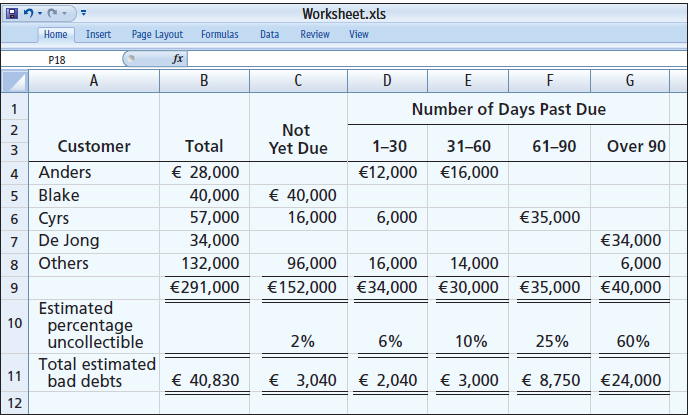
At December 31, 2017, the unadjusted balance in Allowance for Doubtful Accounts is a credit of €9,200.
Instructions
- Journalize and post the adjusting entry for bad debts at December 31, 2017.
- Journalize and post to the allowance account the following events and transactions in the year 2018.
- On March 31, a €1,000 customer balance originating in 2017 is judged uncollectible.
- On May 31, a check for €1,000 is received from the customer whose account was written off as uncollectible on March 31.
- Journalize the adjusting entry for bad debts on December 31, 2018, assuming that the unadjusted balance in Allowance for Doubtful Accounts is a debit of €1,100 and the aging schedule indicates that total estimated bad debts will be €31,600.
Journalize transactions related to bad debts.
P8-4A Hú Ltd. uses the allowance method to estimate uncollectible accounts receivable. The company produced the following aging of the accounts receivable at year-end.
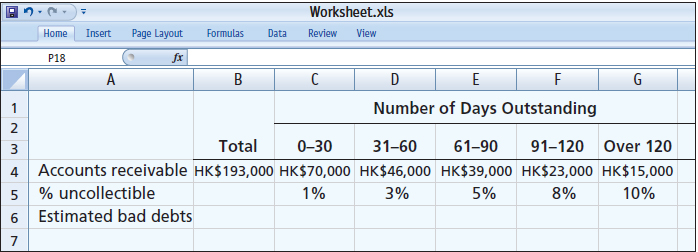
Instructions
- Calculate the total estimated bad debts based on the information on page 414.
- Prepare the year-end adjusting journal entry to record the bad debts using the aged uncollectible accounts receivable determined in (a). Assume the current balance in Allowance for Doubtful Accounts is a HK$3,000 debit.
- Of the above accounts, HK$5,000 is determined to be specifically uncollectible. Prepare the journal entry to write off the uncollectible account.
- The company collects HK$5,000 subsequently on a specific account that had previously been determined to be uncollectible in (c). Prepare the journal entry(ies) necessary to restore the account and record the cash collection.
 Comment on how your answers to (a)–(d) would change if Hú Ltd. used 3% of total accounts receivable, rather than aging the accounts receivable. What are the advantages to the company of aging the accounts receivable rather than applying a percentage to total accounts receivable?
Comment on how your answers to (a)–(d) would change if Hú Ltd. used 3% of total accounts receivable, rather than aging the accounts receivable. What are the advantages to the company of aging the accounts receivable rather than applying a percentage to total accounts receivable?
Journalize entries to record transactions related to bad debts.
P8-5A At December 31, 2017, the trial balance of Roberto SpA contained the following amounts before adjustment.
| Debit | Credit | |
| Accounts Receivable | €385,000 | |
| Allowance for Doubtful Accounts | € 800 |
|
| Sales Revenue | 918,000 |
Instructions
- Based on the information given, which method of accounting for bad debts is Roberto using—the direct write-off method or the allowance method? How can you tell?
- Prepare the adjusting entry at December 31, 2017, for bad debt expense under each of the following independent assumptions.
- An aging schedule indicates that €12,400 of accounts receivable will be uncollectible.
- The company estimates that 1% of sales will be uncollectible.
- Repeat part (b) assuming that instead of a credit balance there is an €960 debit balance in Allowance for Doubtful Accounts.
- During the next month, January 2018, a €3,000 account receivable is written off as uncollectible. Prepare the journal entry to record the write-off.
- Repeat part (d) assuming that Roberto uses the direct write-off method instead of the allowance method in accounting for uncollectible accounts receivable.
 What type of account is Allowance for Doubtful Accounts? How does it affect how accounts receivable is reported on the statement of financial position at the end of the accounting period?
What type of account is Allowance for Doubtful Accounts? How does it affect how accounts receivable is reported on the statement of financial position at the end of the accounting period?
Prepare entries for various notes receivable transactions.
P8-6A Hilo Ltd. closes its books monthly. On September 30, selected ledger account balances are:
| Notes Receivable | £31,000 |
| Interest Receivable | 170 |
Notes Receivable include the following.
| Date | Maker | Face | Term | Interest |
| Aug. 16 | Demaster Ltd. | £ 8,000 |
60 days | 8% |
| Aug. 25 | Skinner Co. | 9,000 |
60 days | 10% |
| Sept. 30 | Almer Ltd. | 14,000 |
6 months | 9% |
Interest is computed using a 360-day year. During October, the following transactions were completed.
| Oct. | 7 |
Made sales of £6,300 on Hilo credit cards. |
12 |
Made sales of £1,200 on MasterCard credit cards. The credit card service charge is 3%. | |
15 |
Added £460 to Hilo customer balance for finance charges on unpaid balances. | |
15 |
Received payment in full from Demaster Ltd. on the amount due. | |
24 |
Received notice that the Skinner note has been dishonored. (Assume that Skinner is expected to pay in the future.) |
Instructions
- Journalize the October transactions and the October 31 adjusting entry for accrued interest receivable.
- Enter the balances at October 1 in the receivable accounts. Post the entries to all of the receivable accounts.
- Show the statement of financial position presentation of the receivable accounts at October 31.
Prepare entries for various receivable transactions.
P8-7A On January 1, 2017, Derek Co. had Accounts Receivable €139,000, Notes Receivable €30,000, and Allowance for Doubtful Accounts €13,200. The note receivable is from Kaye Noonan Ltd. It is a 4-month, 9% note dated December 31, 2016. Derek prepares financial statements annually at December 31. During the year, the following selected transactions occurred.
| Jan. | 5 |
Sold €24,000 of merchandise to Zwingle SE, terms n/15. |
20 |
Accepted Zwingle’s €24,000, 3-month, 6% note for balance due. | |
| Feb. | 18 |
Sold €8,000 of merchandise to Gerard AG and accepted Gerard’s €8,000, 6-month, 7% note for the amount due. |
| Apr. | 20 |
Collected Zwingle note in full. |
30 |
Received payment in full from Kaye Noonan on the amount due. | |
| May | 25 |
Accepted Isabella Ltd.’s €4,000, 3-month, 7% note in settlement of a past-due balance on account. |
| Aug. | 18 |
Received payment in full from Gerard on note due. |
25 |
The Isabella note was dishonored. Isabella is not bankrupt; future payment is anticipated. | |
| Sept. | 1 |
Sold €10,000 of merchandise to Fernando Co. and accepted a €10,000, 6-month, 8% note for the amount due. |
Instructions
Journalize the transactions.
PROBLEMS: SET B
Prepare journal entries related to bad debt expense.
P8-1B At December 31, 2016, Globe Trotter Imports reported the following information on its statement of financial position.
| Accounts receivable | €220,000 |
| Less: Allowance for doubtful accounts | 15,000 |
During 2017, the company had the following transactions related to receivables.
| 1. Sales on account | €2,400,000 |
| 2. Sales returns and allowances | 45,000 |
| 3. Collections of accounts receivable | 2,250,000 |
| 4. Write-offs of accounts receivable deemed uncollectible | 10,600 |
| 5. Recovery of bad debts previously written off as uncollectible | 2,000 |
Instructions
- Prepare the journal entries to record each of these five transactions. Assume that no cash discounts were taken on the collections of accounts receivable.
- Enter the January 1, 2017, balances in Accounts Receivable and Allowance for Doubtful Accounts. Post the entries to the two accounts (use T-accounts), and determine the balances.
- Prepare the journal entry to record bad debt expense for 2017, assuming that an aging of accounts receivable indicates that estimated bad debts are €21,400.
- Compute the accounts receivable turnover for the year 2017, assuming the expected bad debt information presented in (c).
Compute bad debt amounts.
P8-2B Information related to Izmir A.Ş. for 2017 is summarized below.
| Total credit sales | |
| Accounts receivable at December 31 | 369,000 |
| Bad debts written off | 23,400 |
Instructions
- What amount of bad debt expense will Izmir report if it uses the direct write-off method of accounting for bad debts?
- Assume that Izmir decides to estimate its bad debt expense to be 3% of credit sales. What amount of bad debt expense will Izmir record if Allowance for Doubtful Accounts has a credit balance of
 3,000?
3,000? - Assume that Izmir decides to estimate its bad debt expense based on 7% of accounts receivable. What amount of bad debt expense will Izmir record if Allowance for Doubtful Accounts has a credit balance of
 4,000?
4,000? - Assume the same facts as in (c), except that there is a
 2,000 debit balance in Allowance for Doubtful Accounts. What amount of bad debt expense will Izmir record?
2,000 debit balance in Allowance for Doubtful Accounts. What amount of bad debt expense will Izmir record?  What is the weakness of the direct write-off method of reporting bad debt expense?
What is the weakness of the direct write-off method of reporting bad debt expense?
Journalize entries to record transactions related to bad debts.
P8-3B Presented below is an aging schedule for Garry Owen plc.
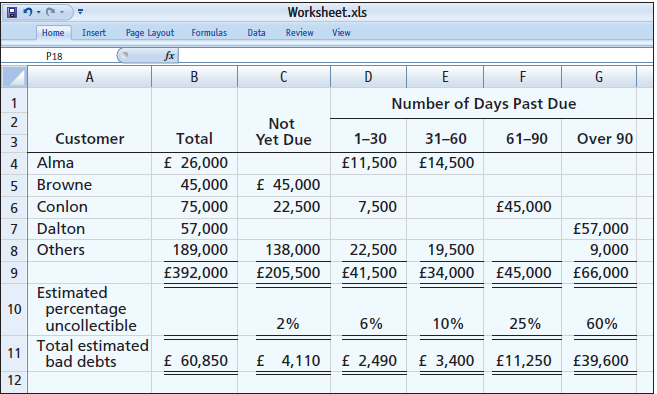
At December 31, 2017, the unadjusted balance in Allowance for Doubtful Accounts is a credit of £14,000.
Instructions
- Journalize and post the adjusting entry for bad debts at December 31, 2017.
- Journalize and post to the allowance account the following events and transactions in the year 2018.
- March 1, a £1,900 customer balance originating in 2017 is judged uncollectible.
- May 1, a check for £1,900 is received from the customer whose account was written off as uncollectible on March 1.
- Journalize the adjusting entry for bad debts on December 31, 2018. Assume that the unadjusted balance in Allowance for Doubtful Accounts is a debit of £3,400, and the aging schedule indicates that total estimated bad debts will be £48,300.
Journalize transactions related to bad debts.
P8-4B The following represents selected information taken from a company’s aging schedule to estimate uncollectible accounts receivable at year-end.

Instructions
- Calculate the total estimated bad debts based on the information on page 417.
- Prepare the year-end adjusting journal entry to record the bad debts using the allowance method and the aged uncollectible accounts receivable determined in (a). Assume the current balance in Allowance for Doubtful Accounts is a CHF1,600 credit.
- Of the above accounts, CHF1,100 is determined to be specifically uncollectible. Prepare the journal entry to write off the uncollectible accounts.
- The company subsequently collects CHF700 on a specific account that had previously been determined to be uncollectible in (c). Prepare the journal entry(ies) necessary to restore the account and record the cash collection.
 Explain how establishing an allowance account satisfies the expense recognition principle.
Explain how establishing an allowance account satisfies the expense recognition principle.
Journalize entries to record transactions related to bad debts.
P8-5B At December 31, 2017, the trial balance of Mariette SA contained the following amounts before adjustment.
| Debit | Credit | |
| Accounts Receivable | €250,000 |
|
| Allowance for Doubtful Accounts | € 1,900 |
|
| Sales Revenue | 600,000 |
Instructions
- Prepare the adjusting entry at December 31, 2017, to record bad debt expense under each of the following independent assumptions.
- An aging schedule indicates that €13,800 of accounts receivable will be uncollectible.
- The company estimates that 2% of sales will be uncollectible.
- Repeat part (a) assuming that instead of a credit balance, there is a €1,900 debit balance in Allowance for Doubtful Accounts.
- During the next month, January 2018, a €3,000 account receivable is written off as uncollectible. Prepare the journal entry to record the write-off.
- Repeat part (c) assuming that Mariette uses the direct write-off method instead of the allowance method in accounting for uncollectible accounts receivable.
 What are the advantages of using the allowance method in accounting for uncollectible accounts as compared to the direct write-off method?
What are the advantages of using the allowance method in accounting for uncollectible accounts as compared to the direct write-off method?
Prepare entries for various notes receivable transactions.
P8-6B Gehrig Co. closes its books monthly. On June 30, selected ledger account balances are:
| Notes Receivable | €60,000 |
| Interest Receivable | 435 |
Notes Receivable include the following.
| Date | Maker | Face | Term | Interest |
| May 16 | Fulton Ltd. | €12,000 |
60 days | 9% |
| May 25 | Ascot Co. | 30,000 |
60 days | 10% |
| June 30 | Trayer Corp. | 18,000 |
6 months | 12% |
During July, the following transactions were completed.
| July | 5 |
Made sales of €7,200 on Gehrig Co. credit cards. |
14 |
Made sales of €1,300 on Visa credit cards. The credit card service charge is 3%. | |
14 |
Added €510 to Gehrig Co. credit card customer balances for finance charges on unpaid balances. | |
15 |
Received payment in full from Fulton Ltd. on the amount due. | |
24 |
Received notice that the Ascot Co. note has been dishonored. (Assume that Ascot Co. is expected to pay in the future.) |
Instructions
- Journalize the July transactions and the July 31 adjusting entry for accrued interest receivable. (Interest is computed using 360 days.)
- Enter the balances at July 1 in the receivable accounts. Post the entries to all of the receivable accounts.
- Show the statement of financial position presentation of the receivable accounts at July 31.
Prepare entries for various receivable transactions.
P8-7B On January 1, 2017, Valdez SA had Accounts Receivable €91,000 and Allowance for Doubtful Accounts €8,100. Valdez prepares financial statements annually at December 31. During the year, the following selected transactions occurred.
| Jan. | 5 |
Sold €8,400 of merchandise to Patrick Co., terms n/30. |
| Feb. | 2 |
Accepted an €8,400, 4-month, 5% promissory note from Patrick for the balance due. |
12 |
Sold €13,500 of merchandise to Marguerite SA and accepted Marguerite’s €13,500, 2-month, 6% note for the balance due. | |
26 |
Sold €7,000 of merchandise to Felton Co., terms n/10. | |
| Apr. | 5 |
Accepted a €7,000, 3-month, 8% note from Felton Co. for the balance due. |
12 |
Collected Marguerite note in full. | |
| June | 2 |
Collected Patrick note in full. |
| July | 5 |
Felton Co. dishonors its note of April 5. It is expected that Felton will eventually pay the amount owed. |
15 |
Sold €11,000 of merchandise to Planke Co. and accepted Planke’s €11,000, 3-month, 8% note for the amount due. | |
| Oct. | 15 |
Planke Co.’s note was dishonored. Planke Co. is bankrupt, and there is no hope of future settlement. |
Instructions
Journalize the transactions.
COMPREHENSIVE PROBLEM
CP8 Victoria Company, Ltd.’s statement of financial position at December 31, 2016, is presented below.

During January 2017, the following transactions occurred. Victoria uses the perpetual inventory method.
| Jan. | 1 |
Victoria accepted a 4-month, 8% note from Leon plc in payment of Leon’s £1,500 account. |
3 |
Victoria wrote off as uncollectible the accounts of Barker Ltd. (£450) and Elmo Co. (£330). | |
8 |
Victoria purchased £17,200 of inventory on account. | |
11 |
Victoria sold for £25,000 on account inventory that cost £17,500. | |
15 |
Victoria sold inventory that cost £780 to Joe Haribo for £1,200. Haribo charged this amount on his Visa First Bank card. The service fee charged Victoria by First Bank is 3%. | |
17 |
Victoria collected £22,900 from customers on account. | |
21 |
Victoria paid £16,300 on accounts payable. | |
24 |
Victoria received payment in full (£330) from Elmo on the account written off on January 3. | |
27 |
Victoria purchased supplies for £1,400 cash. | |
31 |
Victoria paid other operating expenses, £3,218. |
Adjustment data:
- Interest is recorded for the month on the note from January 1.
- Bad debts are expected to be 5% of the January 31, 2017, accounts receivable.
- A count of supplies on January 31, 2017, reveals that £470 remains unused.
Instructions
(You may want to set up T-accounts to determine ending balances.)
- Prepare journal entries for the transactions on page 419 and the adjusting entries. (Include entries for cost of goods sold using the perpetual system.)
- Prepare an adjusted trial balance at January 31, 2017.
- Prepare an income statement and a retained earnings statement for the month ending January 31, 2017, and a classified statement of financial position as of January 31, 2017.
MATCHA CREATIONS

(Note: This is a continuation of the Matcha Creations problem from Chapters 1–7.)
MC8 One of Mei-ling’s friends, Curtis Lesperance, runs a coffee shop where he sells specialty coffees and prepares and sells muffins and cookies. He is eager to buy one of Mei-ling’s fine European mixers, which would enable him to make larger batches of muffins and cookies. However, Curtis cannot afford to pay for the mixer for at least 30 days. He asks Mei-ling if she would be willing to sell him the mixer on credit. Mei-ling comes to you for advice.
Go to the book’s companion website, www.wiley.com/college/weygandt, to see the completion of this problem.
BROADENING YOUR PERSPECTIVE
Financial Reporting and Analysis
Financial Reporting Problem
BYP8-1 CAF AG sells office equipment and supplies to many organizations in the city and surrounding area on contract terms of 2/10, n/30. In the past, over 75% of the credit customers have taken advantage of the discount by paying within 10 days of the invoice date.
The number of customers taking the full 30 days to pay has increased within the last year. Current indications are that less than 60% of the customers are now taking the discount. Bad debts as a percentage of gross credit sales have risen from the 2.5% provided in past years to about 4.5% in the current year.
The company’s Finance Committee has requested more information on the collections of accounts receivable. The controller responded to this request with the report reproduced below.
| CAF AG Accounts Receivable Collections May 31, 2017 |
The fact that some credit accounts will prove uncollectible is normal. Annual bad debt write-offs have been 2.5% of gross credit sales over the past 5 years. During the last fiscal year, this percentage increased to slightly less than 4.5%. The current Accounts Receivable balance is €1,400,000. The condition of this balance in terms of age and probability of collection is as follows.
| Proportion of Total | Age Categories | Probability of Collection |
60% |
not yet due | 98% |
22% |
less than 30 days past due | 96% |
9% |
30 to 60 days past due | 94% |
5% |
61 to 120 days past due | 91% |
2½% |
121 to 180 days past due | 75% |
1½% |
over 180 days past due | 30% |
Allowance for Doubtful Accounts had a credit balance of €29,500 on June 1, 2016. CAF has provided for a monthly bad debt expense accrual during the current fiscal year based on the assumption that 4.5% of gross credit sales will be uncollectible. Total gross credit sales for the 2016–2017 fiscal year amounted to €2,800,000. Write-offs of bad accounts during the year totaled €102,000.
Instructions
- Prepare an accounts receivable aging schedule for CAF using the age categories identified in the controller’s report to the Finance Committee showing the following.
- The amount of accounts receivable outstanding for each age category and in total.
- The estimated amount that is uncollectible for each category and in total.
- Compute the amount of the year-end adjustment necessary to bring Allowance for Doubtful Accounts to the balance indicated by the age analysis. Then prepare the necessary journal entry to adjust the accounting records.
- In a recessionary environment with tight credit and high interest rates:
- Identify steps CAF might consider to improve the accounts receivable situation.
- Then evaluate each step identified in terms of the risks and costs involved.
Comparative Analysis Problem: Nestlé SA (CHE) vs. Petra Foods Ltd. (SGP)
BYP8-2 Nestlé’s financial statements are presented in Appendix B. Financial statements of Petra Foods are presented in Appendix C.
Instructions
- Based on the information in these financial statements, compute the following ratios for each company for the most recent fiscal year shown. (Assume all sales are credit sales and that all receivables are trade receivables.)
- Accounts receivable turnover.
- Average collection period for receivables.
- What conclusions about managing accounts receivable can you draw from these data?
Real-World Focus
BYP8-3 Purpose: To learn more about factoring from websites that provide factoring services.
Address: www.comcapfactoring.com
Steps: Go to the website, click on Invoice Factoring, and answer the following questions.
- What are some of the benefits of factoring?
- What is the range of the percentages of the typical discount rate?
- If a company factors its receivables, what percentage of the value of the receivables can it expect to receive from the factor in the form of cash, and how quickly will it receive the cash?
Critical Thinking
 Decision-Making Across the Organization
Decision-Making Across the Organization
BYP8-4 Hilda and Tim Piwek own Campus Fashions. From its inception, Campus Fashions has sold merchandise on either a cash or credit basis, but no credit cards have been accepted. During the past several months, the Piweks have begun to question their sales policies. First, they have lost some sales because of refusing to accept credit cards. Second, representatives of two metropolitan banks have been persuasive in almost convincing them to accept their national credit cards. One bank, City National Bank, has stated that its credit card fee is 4%.
The Piweks decide that they should determine the cost of carrying their own credit sales. From the accounting records of the past 3 years, they accumulate the following data.
| 2017 | 2016 | 2015 | |
| Net credit sales | €500,000 |
€650,000 |
€400,000 |
| Collection agency fees for slow-paying customers | 2,450 |
2,500 |
2,300 |
| Salary of part-time accounts receivable clerk | 4,100 |
4,100 |
4,100 |
Credit and collection expenses as a percentage of net credit sales are uncollectible accounts 1.6%, billing and mailing costs 0.5%, and credit investigation fee on new customers 0.15%.
Hilda and Tim also determine that the average accounts receivable balance outstanding during the year is 5% of net credit sales. The Piweks estimate that they could earn an average of 8% annually on cash invested in other business opportunities.
Instructions
With the class divided into groups, answer the following.
- Prepare a table showing, for each year, total credit and collection expenses in euros and as a percentage of net credit sales.
- Determine the net credit and collection expense in euros and as a percentage of sales after considering the revenue not earned from other investment opportunities.
- Discuss both the financial and non-financial factors that are relevant to the decision.
Communication Activity
BYP8-5 Lily Pao, a friend of yours, overheard a discussion at work about changes her employer wants to make in accounting for uncollectible accounts. Lily knows little about accounting, and she asks you to help make sense of what she heard. Specifically, she asks you to explain the differences between the percentage-of-sales, percentage-of-receivables, and the direct write-off methods for uncollectible accounts.
Instructions
In a letter of one page (or less), explain to Lily the three methods of accounting for uncollectibles. Be sure to discuss differences among these methods.
Ethics Case

BYP8-6 The controller of Vestin Co. believes that the yearly allowance for doubtful accounts for Vestin Co. should be 2% of net credit sales. The president of Vestin Co., nervous that the shareholders might expect the company to sustain its 10% growth rate, suggests that the controller increase the allowance for doubtful accounts to 4%. The president thinks that the lower net income, which reflects a 6% growth rate, will be a more sustainable rate for Vestin Co.
Instructions
- Who are the stakeholders in this case?
- Does the president’s request pose an ethical dilemma for the controller?
- Should the controller be concerned with Vestin Co.’s growth rate? Explain your answer.
Answers to Insight and Accounting Across the Organization Questions
p. 394 How Does a Credit Card Work? Q: Assume that PPR prepares a bank reconciliation at the end of each month. If some credit card sales have not been processed by the bank, how should PPR treat these transactions on its bank reconciliation? A: PPR would treat the credit card receipts as deposits in transit. It has already recorded the receipts as cash. Its bank will increase PPR’s cash account when it receives the receipts.
p. 398 Can Fair Value Be Unfair? Q: What are the arguments in favor of and against fair value accounting for loans and receivables? A: Arguments in favor of fair value accounting for loans and receivables are that fair value would provide a more accurate view of a company’s financial position. This might provide a useful early warning of when a bank or other financial institution was in trouble because its loans were of poor quality. But, banks argue that estimating fair values is very difficult to do accurately. They are also concerned that volatile fair values could cause large swings in a bank’s reported net income.
p. 400 Filling a Lending Void Q: Why do you suppose the company prefers to extend credit supported by receivables rather than intangible assets? A: Receivables are much more liquid in nature, that is, much easier to convert to cash. Intangible assets (such as patents) do not tend to have a readily available market for sale and thus would be much more difficult to convert to cash in the event of a default by the borrower.
A Look at U.S. GAAP
Learning Objective 10
Compare the accounting for receivables under IFRS and U.S. GAAP.
The basic accounting and reporting issues related to recognition and measurement of receivables, such as the use of allowance accounts, how to record trade and sales discounts, use of percentage-of-sales and percentage-of-receivables methods, and factoring, are essentially the same under both IFRS and GAAP.
Key Points
- Receivables are generally reported in the current assets section of the statement of financial position (balance sheet) under GAAP and IFRS. However, companies that use GAAP report receivables in the current assets section generally after cash, based on liquidity. IFRS often does not use liquidity as a basis for placement in the current assets section. As a result, receivables are often reported after inventory and other current assets except for cash.
- Like the IASB, the FASB has worked to implement fair value measurement for all financial instruments, but both Boards have faced bitter opposition from various factions. As a consequence, the Boards have adopted a piecemeal approach; the first step is disclosure of fair value information in the notes. The second step is the fair value option, which permits, but does not require, companies to record some types of financial instruments at fair value in the financial statements. Both Boards have indicated that they believe all financial instruments should be recorded and reported at fair value.
- Recently, the FASB and IASB completed a project on how to measure fair value. The project, however, was silent on when to report fair value.
Similarities
- GAAP and IFRS account for bad debts in a similar fashion. Both account for short-term receivables at amortized cost, adjusted for allowances for doubtful accounts.
Differences
- IFRS and GAAP differ in the criteria used to derecognize (generally through a sale or factoring) a receivable. IFRS uses a combination approach focused on risks and rewards and loss of control. GAAP uses loss of control as the primary criterion. In addition, IFRS permits partial derecognition; GAAP does not.
- IFRS specifies a two-step process for determining the impairment of receivables for a period. This process starts by identifying individual impairments of specific receivables and then estimating impairments of groups of receivables. GAAP does not specify a similar approach.
Looking to the Future
It appears likely that the question of recording fair values for financial instruments will continue to be an important issue to resolve as the Boards work toward convergence. Both the IASB and the FASB have indicated that they believe that financial statements would be more transparent and understandable if companies recorded and reported all financial instruments at fair value.
That said, in IFRS 9, which was issued in 2009, the IASB created a split model, where some financial instruments are recorded at fair value, but other financial assets, such as loans and receivables, can be accounted for at amortized cost if certain criteria are met. Critics say that this can result in two companies with identical securities accounting for those securities in different ways. A proposal by the FASB would require that practically all equity instruments be reported at fair value and that debt instruments may or may not be reported at fair value, depending on whether certain criteria are met. It has been suggested that IFRS 9 will likely be changed or replaced as the FASB and IASB continue to deliberate the best treatment for financial instruments. In fact, one past member of the IASB said that companies should ignore IFRS 9 and continue to report under the old standard because, in his opinion, it was extremely likely that it would be changed before the mandatory adoption date of the standard.
GAAP Practice
GAAP Self-Test Questions
- Under GAAP, receivables are reported on the balance sheet at:
- amortized cost.
- amortized cost less allowance for doubtful accounts.
- historical cost.
- replacement cost.
- Which of the following statements is false?
- Receivables include equity securities purchased by the company.
- Receivables include credit card receivables.
- Receivables include amounts owed by employees as a result of company loans to employees.
- Receivables include amounts resulting from transactions with customers.
- In recording a factoring transaction:
- IFRS focuses on loss of control.
- GAAP focuses on loss of control and risks and rewards.
- IFRS and GAAP allow partial derecognition.
- IFRS allows partial derecognition.
- Under IFRS:
- the entry to record estimated uncollectible accounts is the same as GAAP.
- receivables should only be tested for impairment as a group.
- it is always acceptable to use the direct write-off method.
- all financial instruments are recorded at fair value.
- Which of the following statements is true?
- The fair value option requires that some types of financial instruments be recorded at fair value.
- The fair value option requires that some types of financial instruments be recorded at amortized cost.
- The fair value option allows, but does not require, that some types of financial instruments be recorded at fair value.
- The FASB and IASB would like to reduce the reliance on fair value accounting for financial instruments in the future.
GAAP Exercise
GAAP8-1 What are some steps taken by both the FASB and IASB to move to fair value measurement for financial instruments? In what ways have some of the approaches differed?
GAAP Financial Reporting Problem: Apple Inc.
GAAP8-2 The financial statements of Apple are presented in Appendix D. The company’s complete annual report, including the notes to its financial statements, is available at http://investor.apple.com.
Instructions
Use the company’s financial statements and notes to the financial statements to answer the following questions.
- Calculate the accounts receivable turnover and average collection period for 2013 and 2012. Accounts receivable at September 25, 2011, was $5,369 (in millions).
- What conclusions can you draw from the information in part (a)?
Answers to GAAP Self-Test Questions
- b
- a
- d
- a
- c
